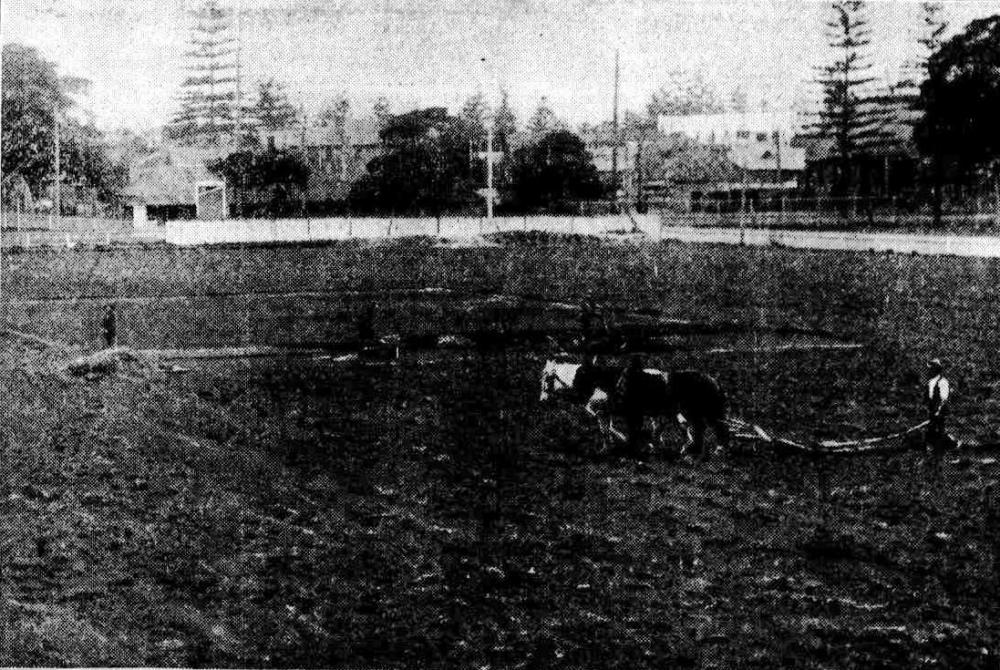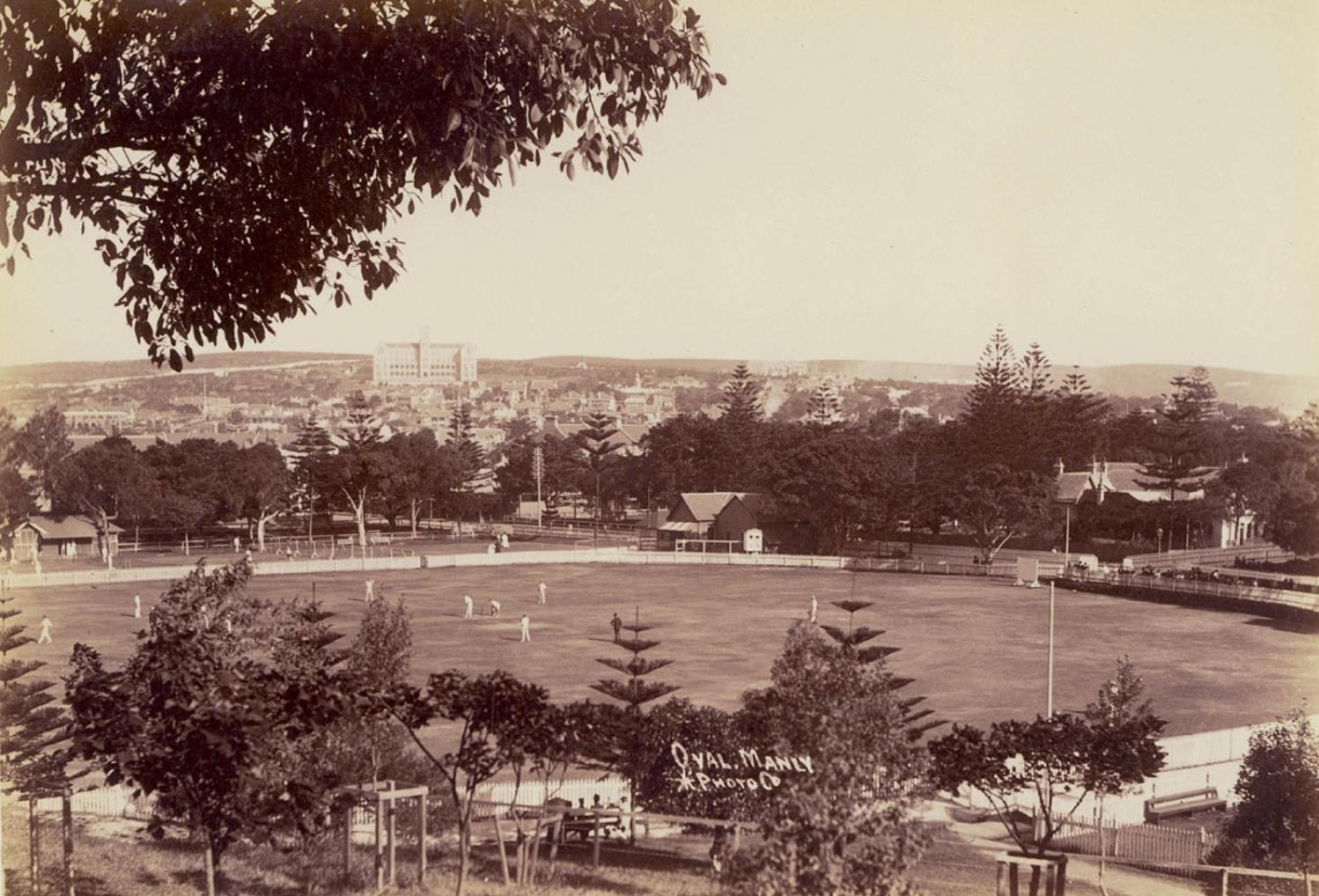Australia's first tour of england cricket team was indigenous: the summer they played at Manly - 1867
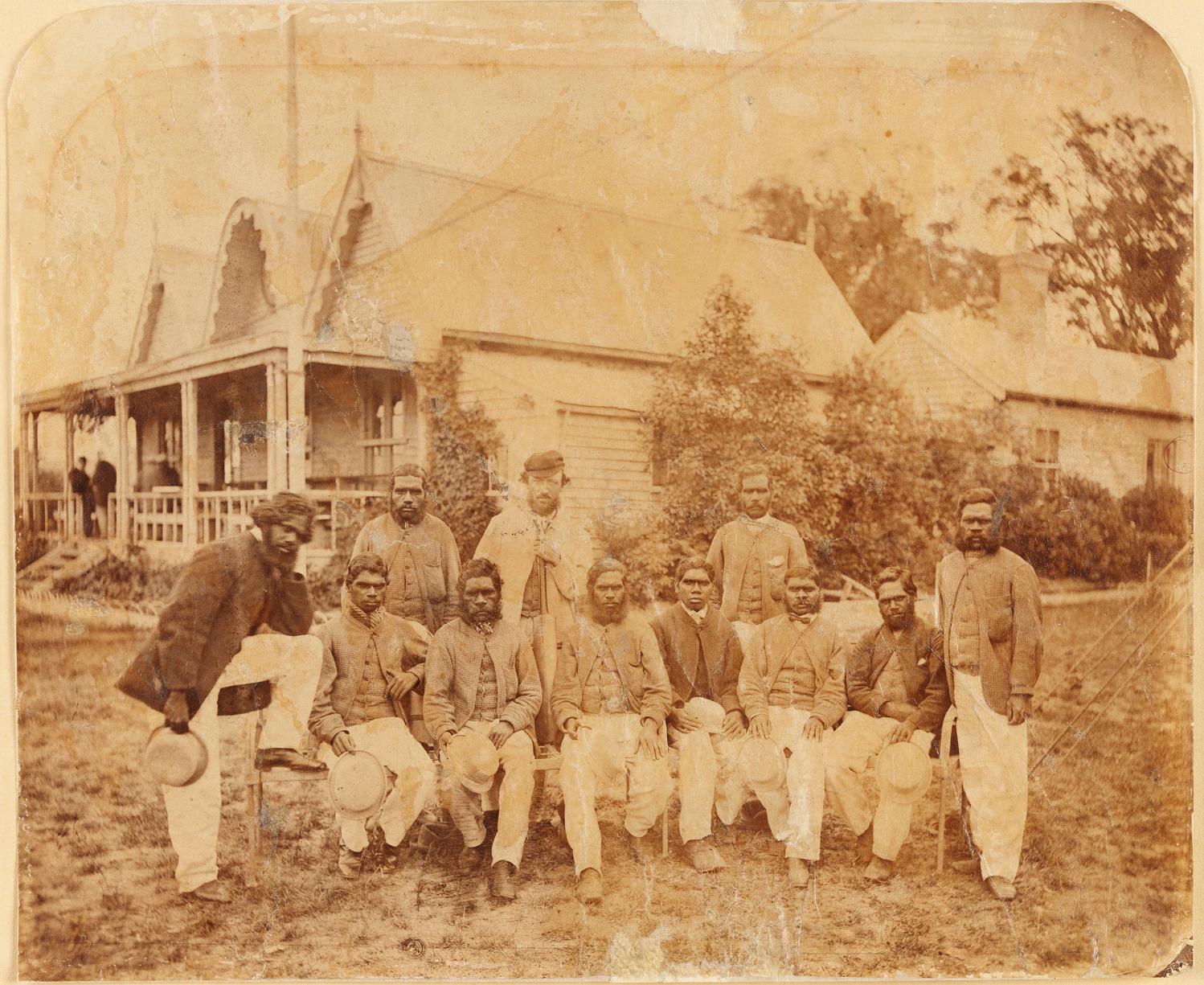
With the cricket season in full swing and locals enjoying their own games as well as watching the Australian men's and women's teams give the visiting teams a bit of a run for their wickets its worth remembering some of our own local cricket history and that the first team to tour the United Kingdom was an indigenous team and that they played at Manly during the Summer of 1867, 155 years ago this February.
This team played over forty matches in England in 1868. The tour was backed by George Smith and Charles Lawrence of Manly, and stayed in quarters at Lawrence’s Pier Hotel at Manly when they came to Sydney. They played at least three matches at Manly between February and March of that year.
THE ABORIGINAL CRICKETERS.
This troupe of sable cricketers left Melbourne for Sydney on Thursday last in the City of Melbourne, they will arrive here tonight, and will take up their quarters at Charley Lawrence's Pier Hotel, Manly Beach. THE ABORIGINAL CRICKETERS. (1867, February 16). Bell's Life in Sydney and Sporting Chronicle (NSW : 1860 - 1870), p. 2. Retrieved from http://nla.gov.au/nla.news-article65466744
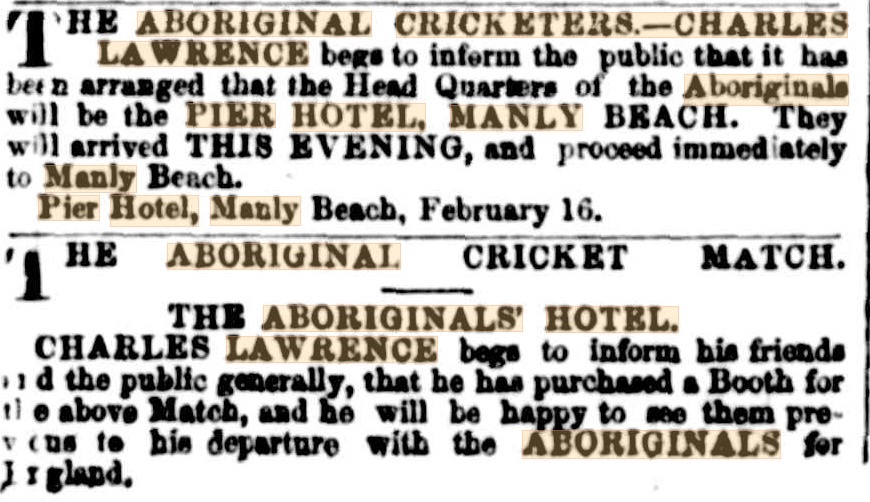
Advertising (1867, February 16). The Sydney Morning Herald (NSW : 1842 - 1954), p. 8. Retrieved from http://nla.gov.au/nla.news-article13148742 - the ‘booth’ was likely installed on Ivanhoe Park or Farrells paddock – although that did not have a cricket pitch on it until 1900 – see Manly Cricket Club meeting of same year below.
Charles Lawrence (December 16th 1828 – January 6th 1917) was an English cricketer, who played for Surrey, Scotland, Ireland and England. He settled in Australia after touring with the First Touring England side in 1861–62.
After the 1861–62 tour, Lawrence settled in Australia and was appointed Australia's first professional cricket coach for the Albert Cricket Club in Redfern, Sydney, to raise the standard of cricket in the state. Appointed captain of New South Wales, Lawrence took a match-winning 14 for 73 against Victoria in his first game. He played five times for the New South Wales cricket team, and in 1863-64 took 4 for 42 and 6 for 48 for New South Wales against an England XI.
Charles Lawrence took over the Pier Hotel in November 1865. A few insights into the Pier Hotel show it was being completed in December 1855 and was advertised by the Morts in that same month and quickly became a place for many to gather. Successive lessors were Phillip Cohen and James Grocott:
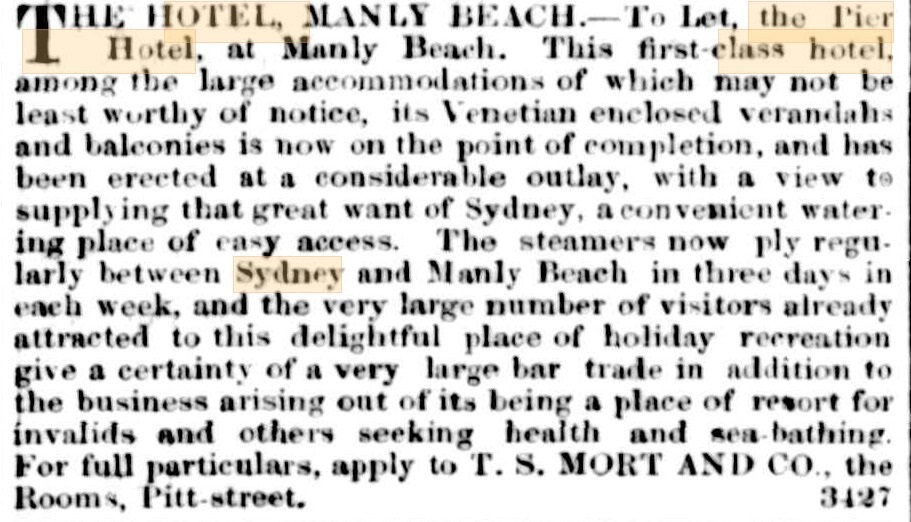
Advertising (1855, December 15). Empire (Sydney, NSW : 1850 - 1875), p. 1. Retrieved from http://nla.gov.au/nla.news-article60171149
THE PIER HOTEL, MANLY BEACH. :
" Shall I not take mine ease in mine Inn."— Shakespere.
J. GORDON GRIFFITHS (for 13 years manager of the Sydney Theatres) beg to announce to his kind friends and patrons the Public, that he has thrown up all his old parts and (" my conscience'") will appear before them in a new character on the Stage of Life that of THE HOST in the entirely ' new production of '
"THE PIER HOTEL," '
AT MANLY BEACH,
which he trusts will not-prove to be one of his least' successful personations.
J. G. G.,- in assuming the direction of this splendid Establishment, feels convinced that he has supplied what has hitherto been felt by the numerous frequenters of this favourite resort lo be a great desideratum, namely : a well appointed house of -rest and refreshment, where both can be obtained, combined with comfort, civility, and moderate charges.
To expatiate in full on the advantages and beauties of this favoured spot would be an impossibility within the narrow 'limits of an advertisement — " Their name Is Legion"— suffice it then to enumerate the most prominent features. The locality possesses all the acknowledged advantages of Wollongong, without the 'drawback of distance. Racked by rugged ' scenery, the lover of nature may here admire her in all the ; " wild pomp of mountain majesty,;" the stern grandeur of the ; cliffs contrasting sublimely with the sombre verdue of the sylvan scenery immediately surrounding the Hotel, while the waters of the Bay in front again agreeably diversify the view, and in their calm placidity afford another beautiful contrast to the dark rolling waters of the BROAD PACIFIC,
A well planked road, plentifully furnished with seats at imposing points of the landscape, soon brings the visitors to CABBAGE TREE BEACH, where a fine white sandy beach borders the open sea for upwards of a mile. The close proximity to the deep sea and. inner fishing ground, will also, it is hoped, secure to this Establishment, the patronage of the disciples of Isaac Walton, who, when recreation becomes a toil, put up their lines and bait themselves, while the peculiar requirements of the Picnic Parties, will meet with every attention from the proprietor, who pledges himself to spare no exertions to facilitate the enjoyment of all, be they high, low, rich, or poor, who may honour his poor " hostelrie " by their patronage and support. -
The house, which is quite new, will be found replete with all the newest improvements of the age we live in, including Cool and very extensive cellarage. It is surrounded by balconies, where two hundred visitors can enjoy the sea breeze and the pleasure grounds will be so laid, as to afford ample accommodation for three thousand more-
A fine Jetty has been constructed for the convenience of passengers by the steamboats which ply continually, at stated intervals, from the Phoenix and Woolloomooloo Wharves. The proprietor in conclusion, -would call attention to his fixed- determination to keep nothing but the best wines, spirits, and malt liquors, at Sydney prices, it being his intention to use every effort to make his House second to no Hotel in the Southern Hemisphere.
J. G. G; feels assured that the arrangements made, for the accommodation of the Public, backed by the inherent attraction of this loveliest of spots, will justify his calling it the Brighton of New South Wales. For pleasure and fishing parties, boats may always be obtained at moderate charges. Advertising (1856, January 26). The People's Advocate and New South Wales Vindicator (Sydney, NSW : 1848-1856), p. 2. Retrieved from http://nla.gov.au/nla.news-article251546425
William Jenkins summoned J. G. Griffiths, of the Pier Hotel, Manly Beach, for wages. There was a great deal of conflicting evidence, and the case was ultimately dismissed. WATER POLICE COURT. (1856, March 28). The Sydney Morning Herald (NSW : 1842 - 1954), p. 4. Retrieved from http://nla.gov.au/nla.news-article12981368
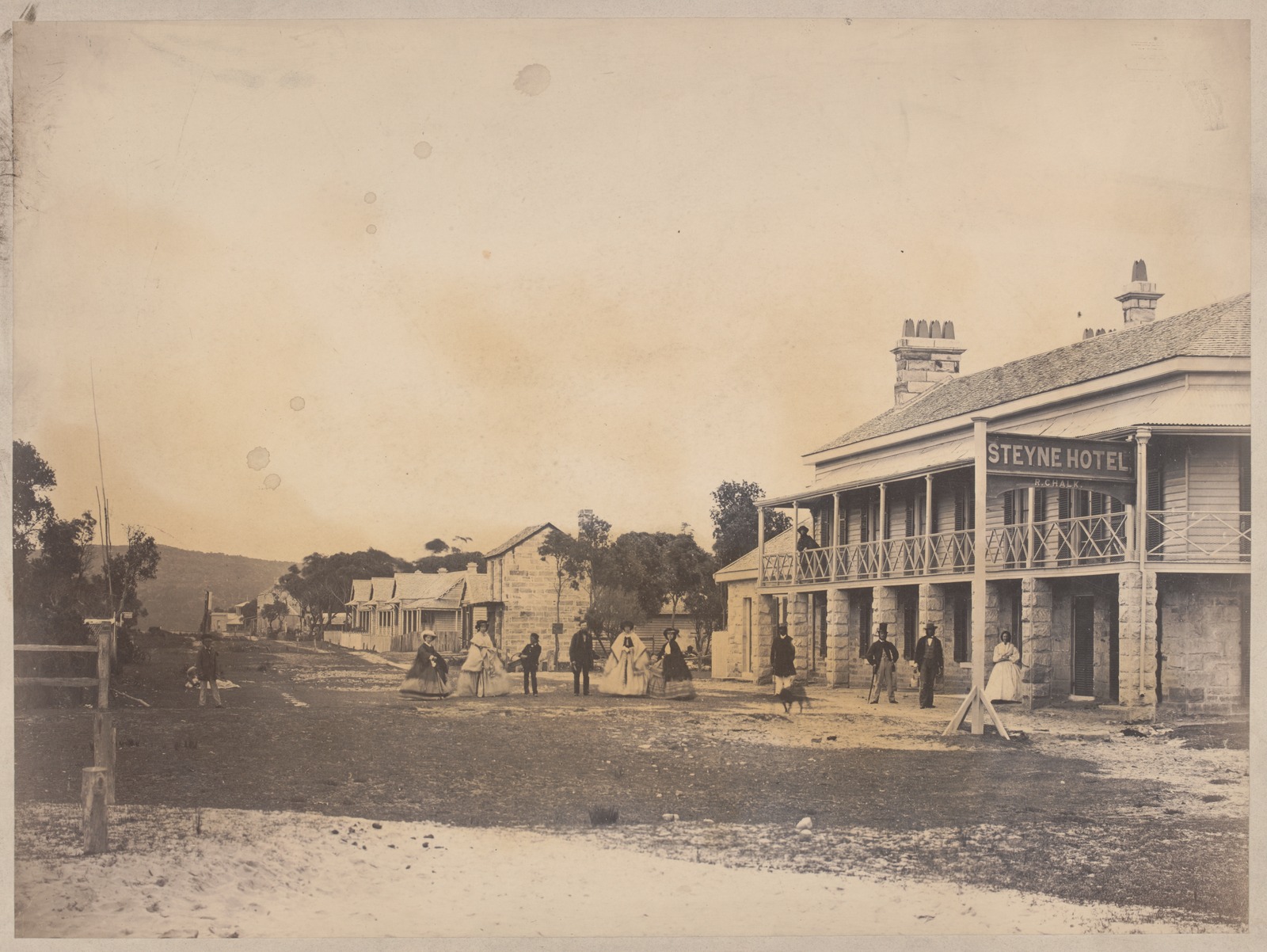
Manly Beach - circa 1860 - courtesy State Library of Victoria - Image No.: H3671.
THE SYDNEY YACHT CLUB'S PICNIC.
The Sydney Yacht Club, which promises soon to be. come one of our institutions, gave a picnic on Saturday last, at which a brilliant company of about three hundred ladies and gentlemen was present. Much pleasure and entertainment was expected to result from this interesting reunion. The morning opened with rather a threatening aspect, but by the time the steamer was ready and got under way, the clouds lifted and formed a screen, which, with a fresh north-east breeze, tended considerably to abate the fervour of a December sun. The Williams steamer had been chartered for the occasion, and she left the Circular Quay at eleven o'clock with her decks crowded. Before going to Manly Beach, the place chosen to hold the picnic, she made a run up Middle Harbour, which of itself was a treat worth going out for. Every one on board was exceedingly delighted with the beauty and grandeur of the scenery that met the gaze: the high and rugged headlands that jutted out into the mid-stream and frowned down upon the steamer as if in anger at her disturbance of the wild solitude that reigned around, and the beautiful little bays that indented the shores, with here and there a snug little cottage, presented a landscape worthy of the pencil of Claude Lorraine. It is no exaggeration to say that Middle Harbour is a most picturesque place; those who have not seen it have not seen half the beauties of Port Jackson and have yet a pleasure to come. A German band on board the steamer lent its aid to enhance the enjoyment of the trip.
After exploring the beauties of Middle Harbour, the steamer proceeded to Manly and disembarked her passengers at the pier. The whole party scattered themselves about just as suited their inclination; some went out on the coast to view the mighty ocean, others strolled along the quiet shore of Big Manly, or rambled through the sombre shade of the bush, and others reposed under the verandahs of the Pier Hotel to watch the yachts of the club working down the harbour. Six yachts, flying the burgee of the club cast anchor in the bay, namely - Eclipse, Enchantress, Challenge, Presto, Mischief, and Truant, forming a squadron of convoy in miniature. After about an hour spent in wandering about, seeing all that was to be seen, the party began gradually to drop in from all quarters, a "silent monitor" within signifying to them that the hour of luncheon had arrived. Luncheon was laid out in the large room of the hotel. The arrangements for this important part of the entertainment were very badly conducted, and a considerable portion of the afternoon was needlessly wasted thereby. The ladies, much to their chagrin, had to go in to luncheon by themselves; and when they had finished, the gentlemen were permitted to partake, thus leaving the ladies again to themselves to pass the time as best they might. This manner of proceeding caused general discontent, and was anything but satisfactory to the ladies, to please whom, we presume, should have been the first consideration with those who had the management of affairs. While on this subject, we may state the supply of substantials fell very far short of the demand; there was scarcely enough on the tables to suffice for one-third of the pleasure party for whom the luncheon was spread. We have been informed, however, that this deficiency arose from the fact of there being more than double the number of persons present that was anticipated. This being also the first picnic given by the club, some allowance will be made for their shortcomings. We think the club were not aware of their popularity, and had no expectation that they would be so well patronised.
After luncheon was over (half-past three o'clock) the room was cleared for dancing, which once began was kept up with vigour till near six o'clock. It was a matter of regret that dancing had not been commenced much earlier, as under its exhilirating influence all minor unpleasantness would not have been regarded. As matters were, however, it was surprising to see what a charm it exercised over its votaries, making them all pleased and joyous, and entirely forgetful of their disappointed appetites. We, however, cannot regard the arrangements for dining and for dancing, under roof, as consistent with pic-nic etiquette; and a suggestion might here be thrown out to the club to have the next picnic in proper style on the green sward, in some pretty shady nook. The club no doubt have perceived the want of arrangement on Saturday last, and will take care that such will not again occur. We are far from finding fault with them, for we believe it is good for man to employ an occasional holiday in social union and festivity; and we cannot but regard the proceedings of the club with a friendly eye.
The signal for starting homewards was given a little before sundown, and all parties hurried on board. A little delay took place in getting the steamer under way, as she lay on the shore - the tide having gone down considerably - and could not be got off easily against the strong southerly squall that had just risen, and which was blowing right into the bay. She was eventually got off all right. On her way up the harbour, Mr. Cuthbert's yacht, Enchantress, was perceived in distress on the rocks a little this side of Shark Beach, and the steamer bore over to render assistance. A warp was got out from the steamer, and taken on board the yacht, and she was eventually towed into deep water apparently out of danger. This occurrence - which in the eyes of the many "fresh water sailors" on board the steamer was quite an adventure worthy to be written in their journals - caused a delay of about an hour, and was the reason of the late arrival of the pleasure party. We understand that the yacht in going about in the squall missed stays, and being on a lee shore, without room to wear, she was put before the wind and run ashore at the most convenient spot. We are happy to state that she has sustained comparatively, little damage; but, had it not been for the timely arrival of the steamer, she might have been literally broken to pieces on the rocks, as it required the most strenuous exertions of her crew to keep her from bumping with the heavy sea that was running at the time.
With the exception of this slight accident, everything went off pretty well; and, notwithstanding the inconveniences above-named, everyone was, in a great mea sure, pleased with the day's amusement. We hope that this disappointment will not throw a damper on the exertions of the club, and prevent them from repeating, whenever they choose, their picnic. They now have a little experience, and will, no doubt, be able to carry out their next in a manner that will leave not the slightest room for complaint, but reflect the highest credit upon themselves. THE SYDNEY YACHT CLUB'S PIC-NIC. (1856, December 22). Empire (Sydney, NSW : 1850 - 1875), p. 4. Retrieved from http://nla.gov.au/nla.news-article64981684
MANLY BEACH QUEEN'S BIRTHDAY REGATTA. - Mr. J. T. Grocott, the successor of Mr. Philip Cohen, in the Pier Hotel, at Manly Beach, is duly evidencing his resolve to multiply the attractions of this picturesque locality. Unrivalled in situation, and commanding two sea views, the one of our beautiful harbour, and the other the open ocean, its claims to take precedence of the various marine retreats in and about Port Jackson can scarcely be disputed. To insure this, the management of the Hotel in a manner satisfactory to the public, is absolutely indispensable, and we believe that Mr. Grocott is fully impressed with this requirement. No title (1859, May 14). Bell's Life in Sydney and Sporting Reviewer (NSW : 1845 - 1860), p. 2. Retrieved from http://nla.gov.au/nla.news-article59870603
In December 1865 it became a cricket place:
PIER HOTEL, MANLY BEACH.
CHARLES LAWRENCE, OF THE ALL ENGLAND ELEVEN,
LATE OF GEORGE STREET, SYDNEY, BEGS to inform his Friends and the Public that he has taken the above HOTEL, and respectfully solicits their support.
Families who have not visited this Suburb, would do well, before engaging Apartments in Sydney, to take a trip by the Steamer.
Ample provision has been made for Amusement. Cricket for the Gentlemen, with gratuitous instruction from Mr. Lawrence; Croquet for the Ladies; a Camera Obscura for the curious and a Maze (like that at Hampton Court) for the Children.
The WINES and! SPIRITS have been selected with great care, and will he found excellent in quality, and the TABLE will be supplied with the best Edibles that can be procured; in fact, C. L. has made such arrangements as cannot fail to give satisfaction to his patrons, and he looks with confidence to the public for a fair share of support.
C. LAWRENCE.
N.B. Charles Lawrence desires to state that he still keeps in stock all kinds of the best Cricketing Materials, at the same prices as supplied from his late Establishment in George street. Classified Advertising (1865, November 4). The Brisbane Courier (Qld. : 1864 - 1933), p. 2. Retrieved from http://nla.gov.au/nla.news-article1281534
Cricket -It is understood that early next week the players will be chosen to represent New South Wales in the forthcoming Intercolonial match with Victoria It is also stated that on Monday week there is to be a grand muster of cricketers at Manly Beach, when the Eleven are to make their appearance in a match After which there are to be festivities at the Pier Hotel, at which most of the distinguished Patrons and friends of cricket are to be present this is intended to serve in some degree as a recognition of the services of Mr Lawrence, and as a reimbursement for the disadvantages he will be under in proceeding to Melbourne, as well as for those losses which he has previously sustained in business. It is, therefore, probable that, as the proposed beneficiare, whilst achieving eminent success in improving the style of cricket in the colony, has by his general deportment in the field and elsewhere gained many well wishers, there will be a numerous and enthusiastic gathering. DEATH OF DR. DOUGLASS. (1865, December 2). The Sydney Morning Herald (NSW : 1842 - 1954), p. 7. Retrieved from http://nla.gov.au/nla.news-article13122638
The Intercolonial Cricket Match. Victoria v. New South Wales
The players selected to represent this colony in the forthcoming match, to be played in Melbourne, and a large number of gentlemen who take a great interest in the game, have made arrangements for a fete at Manly Beach, on Monday next. By the advertisement, bringing the matter to the notice of the public, it will be seen that a grand match-" The Eleven" versus eighteen, to be selected, will be played on the cricket ground adjoining Lawrence's Pier Hotel.
This will be the first and probably the only occasion when the public will have an opportunity of witnessing the play of the New South Wales Eleven previous to their departure for Melbourne. After the match a dinner will be given in the long room, at the hotel. As it is intended that the day's amusement shall at the same time be a substantial benefit to Mr. Lawrence, the present host of the "Pier," and who has devoted so much of his time to our cricketers, a charge will be made for the tickets. With a view to affording recreation for all, Mr. Lawrence has made arrangements for quoits, skittles, and various other games. We have no doubt that, should the weather be propitious, all those who avail themselves of the trip to Manly on Monday will have a very pleasant day, which we hope will also prove of benefit Mr. Lawrence. The Sydney Morning Herald. (1865, December 9). The Sydney Morning Herald (NSW : 1842 - 1954), p. 6. Retrieved from http://nla.gov.au/nla.news-article13122978
CHRISTMAS IN AUSTRALIA.
" To each, to all-to high, to low,
Our greeting is the old one still : The tidings uttered long ago,
Of peace and kindness, and good-will.
"A merry Christmas, then, to all? We utter the good wish once more ;
For sure the greeting will not pall,
Tho' we repeat it o'er and o'er."
THE flight of time has brought us to the close of another year, and ere our next issue is in your hands, kind reader, the year 1865 will be numbered with the past ; its Christmas will have been spent, and its festivities will have ceased. Go where you will, wherever Christianity has been established, the same characteristics mark the season. It is looked forward to by young and old with pleasurable anticipations ; and Australians know how to celebrate it as joyously as if we resided in the land which we all claim as our mother country; True, the modes of our festivities differ almost as' widely as tlie seasons differ in which the Australian and the English Christmas occur. In the latter place it is associated with the garb of winterleafless trees, frost and snow, blazing fires, and all that can conduce to make it an indoor holiday. Families, separate per-haps during the whole year, meet on that day round the hearth-stone of home, under the old roof-tree. The traditionary yule log, the was-sail bowl, the smoking sirloin and plum pud-ding, are as unlikely to be forgotten in the "merry homes of England" as any of the most cherished symbols of its nationality.
"We equally regard the day, but we celebrate it differently : o\\r Christmas is bright and sunny ; the flowers of midsummer deck the garden ; all nature seems to woo us to enjoy ourselves out of doors, and all seem eager to respond to the invitation-hence picnics and excursions by land and water are arranged as being apropos to an Australian Christmas. For such excursions our noble harbour and its picturesque surroundings offers innumerable attractions, but none greater than those of the beautiful seaside village of Manly Beach. What Brighton and Margate are to the Cockney, Boulogne to the Parisian; Newport to the Yankee, Manly Beach is to us. Who has not visited Manly ? A visitor to Sydney who has not been there is looked upon as a visitor to Stratford-on-Avon would be if he neglected to see Shakspeare's house. We are proud of Manly, and justly so. Situated on a narrow strip of land, only a few minutes' walk across, you have on the one side the peaceful waters of Port Jackson laving the shores as softly as au autumn breeze fans the cheek, but on the other the whole force of the South Pacific dashing in foam along the sandy beach, with which it wages perpetual noisy war-the giant breakers, crested with foam, expending their strength in vain, and then, as if breath-less, withdrawing to obtain fresh vigour, and renew the fight again. Scenes of Avondrons rugged beauty are also to be found amongst its rocks and nooks, affording to the lovers of nature numberless treats. Art has also been called upon to contribute its share to the gratification of visitors. A camera tower, swings, a maize, baths, cricket, and croquet, are provided, and last, but not least, at the Pier Hotel (which is shown in the centre of our engraving) Charley Lawrence, of the All-England Eleven, provides creature comforts for all who may stand in need, in the best style.
Readers, we wish you a merry Christmas. May no SORROW or care mar your festivities, and may each returning year find us better and happier than the past. We trust that the connection now established between us may last for years mutually beneficial conducing to your pleasure and our prosperity.
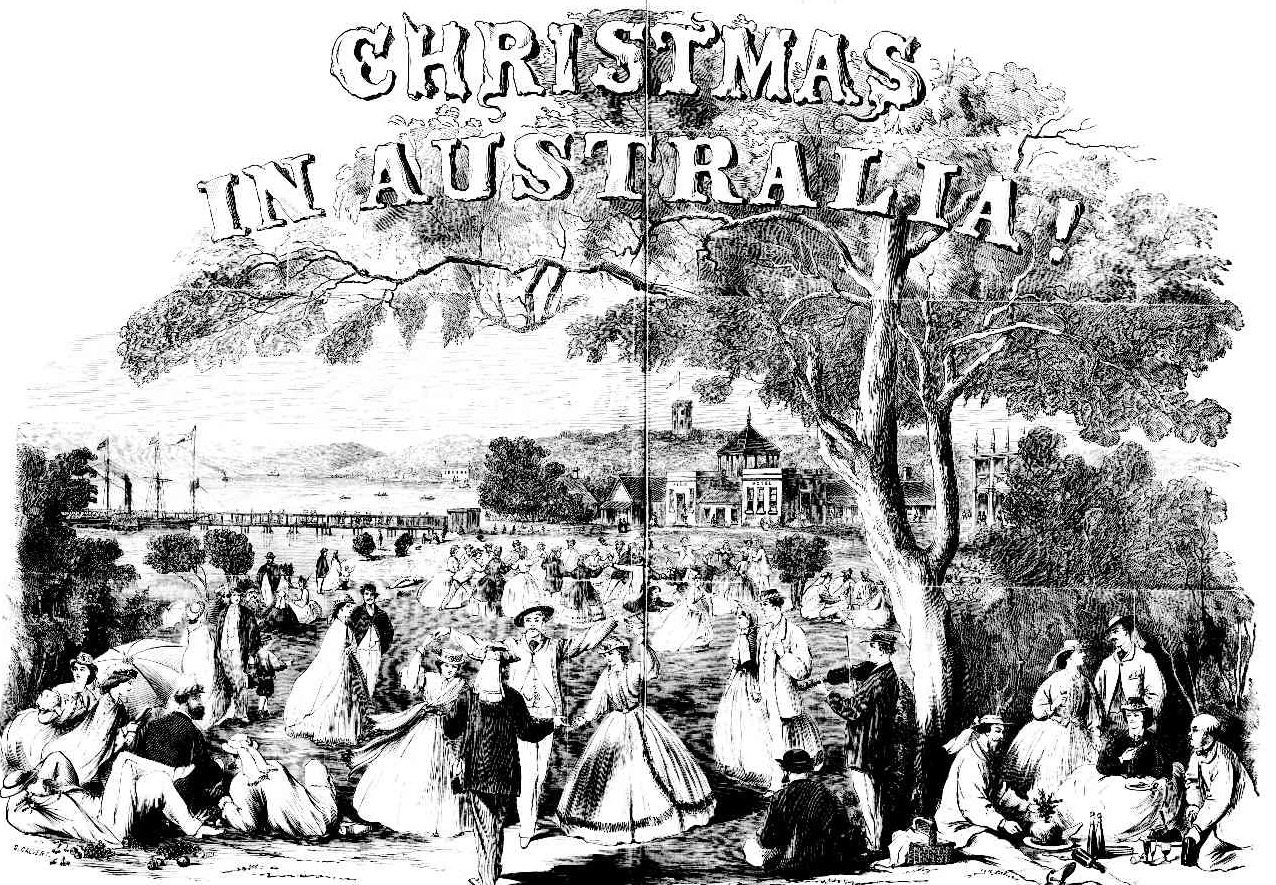
MANLY BEACH ON A PUBLIC HOLIDAY,-[FROM A SKETCH BY OUR ARTIST.]
CHRISTMAS IN AUSTRALIA. (1865, December 16). Illustrated Sydney News (NSW : 1853 - 1872), p. 3. Retrieved from http://nla.gov.au/nla.news-article63512709
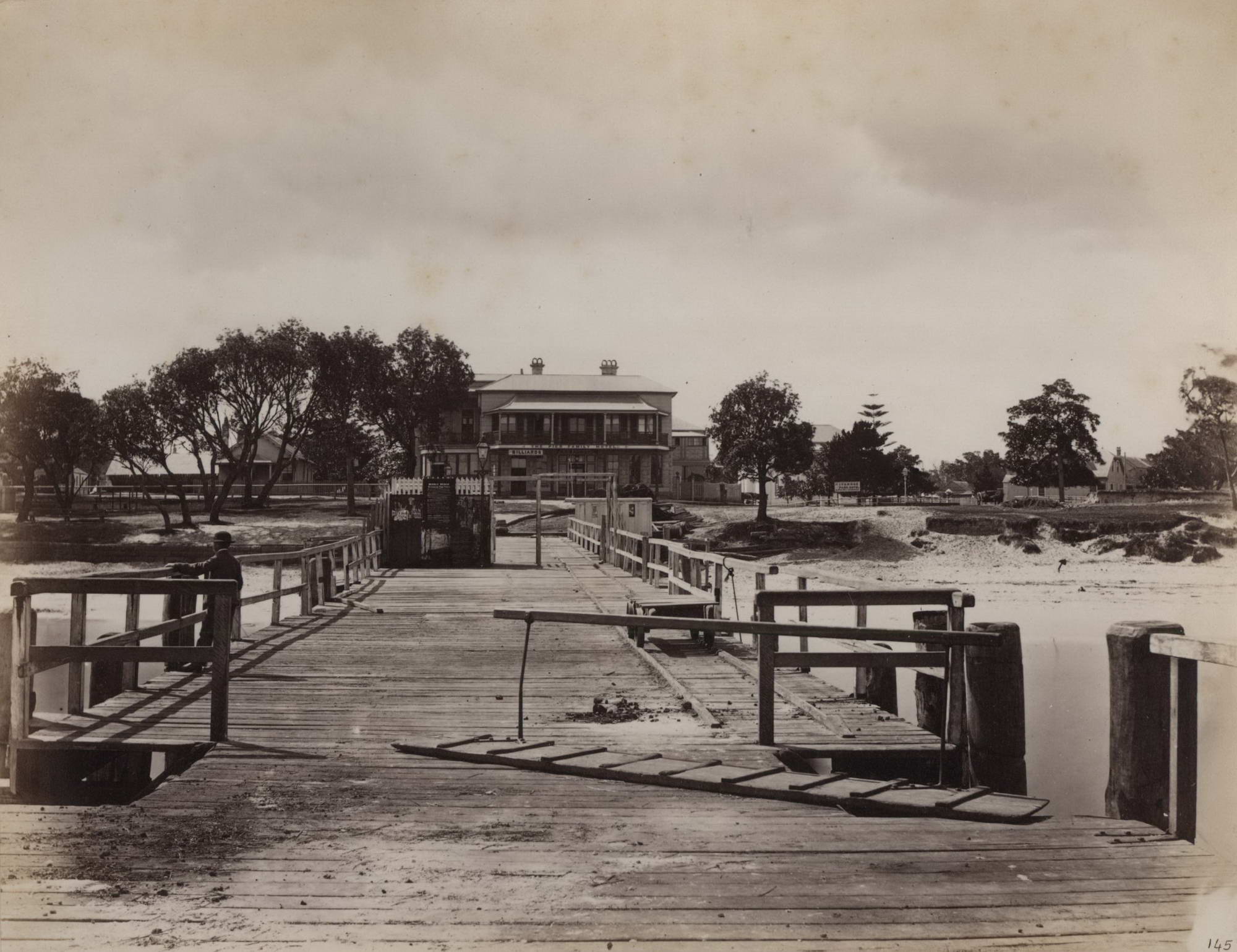
Image, circa 1870, shows the old wharf, in the location of the present Manly Wharf. Visible on the wharf are a Manly Beach Steamer timetable and rail tracks for goods. Signs in the background read “The Pier Family Hotel” and “Ivanhoe Park Hotel and picnic grounds.” Courtesy Josef Lebovic galleries.
Mr. Lawrence first saw the indigenous team under the instruction of Tom Wills playing a match at the Albert Ground. On this occasion there was some contract disagreement between the failed sponsor Gurnett and Wills and the players were left in Sydney. Lawrence was instructed to look after the Aboriginal players. He billeted the players in his hotel in Manly until he could arrange some cricket matches to raise money to return the players to the Western District of Victoria and it was during this time that at least three cricket matches at Manly took place on February 27th, March 16th and March 23rd.
Reports from the newspapers of that Summer and Autumn provide:
CRICKET.
The Australian Club yesterday played a match against Manly Beach, on the ground at the rear of the Pier Hotel, the local players having in their team Lawrence and Wills, and the two best cricketers of the aboriginal players, Cusens and Mullagh. The contest was witnessed by a number of the residents at the Beach besides visitors from the city of the condition and general character of the ground, little that is favourable can he said, its roughness militated against good bowling, and the extent of level is too limited It is, however, improbable, and a good inch of ground would be no unimportant addition to the algae tiers of our principal marine retreat.
The Beachers went first to the wickets, with Smithers and Cusens against the bowling of Sheridan and Howell The first wicket (that of Smithers) fell for 15 Cuzens and Grey for nine more Wills made a stand, and kept his wicket intact till the finish of the innings, but with the exception of Lawrence, who, however, was caught when he had scored b, he obtained little support from his comrades He was the only one who made double figures. All were out for 53.
Of the Australians, who were bowled to by Wills and Lawrence, Howell and Conway were disposed of in the first few overs. Blanchard gave them some trouble, and Sheridan played a bold hitting innings for 54 and not out. H Driver gave some fine batting ran up a score of 23. E Sadler, the other not out, carries 5. The five wickets were lost for 107 and this being a one day's match, determined by the first innings, the Australians proved the winners by 54 runs.
The scores were as under:
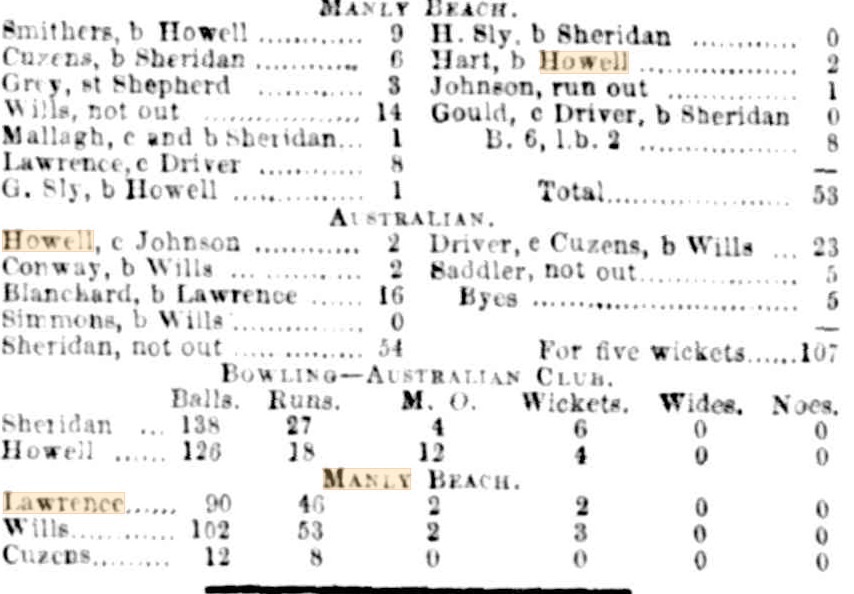
CRICKET. (1867, February 28). The Sydney Morning Herald (NSW : 1842 - 1954), p. 5. Retrieved from http://nla.gov.au/nla.news-article13137880
MANLY BEACH v ABORIGINALS.
A one innings match was played between these clubs on Saturday. In the absence of Lawrence, Wills, with the view of making an even contest, played for Manly Beach, who, in their innings, scored the large total 129, of which Wills contributed 56 (not out), and all the eleven, more or less, succeeded in scoring. The bowling of Cuzens was again worthy of praise, as was also the judicious manner in which Mullagh acted as captain.
Nothing daunted, the Aboriginals then went to the wickets, and succeeded in winning, with two wickets to spare. Mullagh played a splendid innings of 75 (not out). He gave a couple of rather difficult chances towards the end, but several of his hits struck against the trees, and only one run was scored instead of three or four. Cuzens scored well, and the patient play of Peter and Watty enabled Mullagh to get the runs required to win. Jellico was disposed of by a fine catch from Mr. Smith, who fell in the attempt. MANLY BEACH v ABORIGINALS. (1867, March 30 - Saturday). Bell's Life in Sydney and Sporting Chronicle (NSW : 1860 - 1870), p. 2. Retrieved from http://nla.gov.au/nla.news-article65467109
The description of the ground in this first account would seem to describe what would become known as 'Ivanhoe Park' and current site of many a cricket match; Manly Oval. This ground was certainly utilised by the Manly Cricket Club from its formation on Wednesday November 8th, 1871:
A public meeting was held at Manly Beach on Wednesday evening, 1st instant. J. B. Smithers, Esq., J.P., in the chair, for the formation of a cricket club. Thirty-one members were enrolled, and the officers of the Manly Cricket Club appointed. Ivanhoe Park, by the kindness of Thomas Heselton, Esq., has been secured for the practice ground. WARWICK. (1871, November 11 - Saturday). Australian Town and Country Journal (Sydney, NSW : 1870 - 1919), p. 26. Retrieved from http://nla.gov.au/nla.news-article70470113
A sketch from the following year shows a cricket match taking place here as well as the many trees that may have been 'hit':
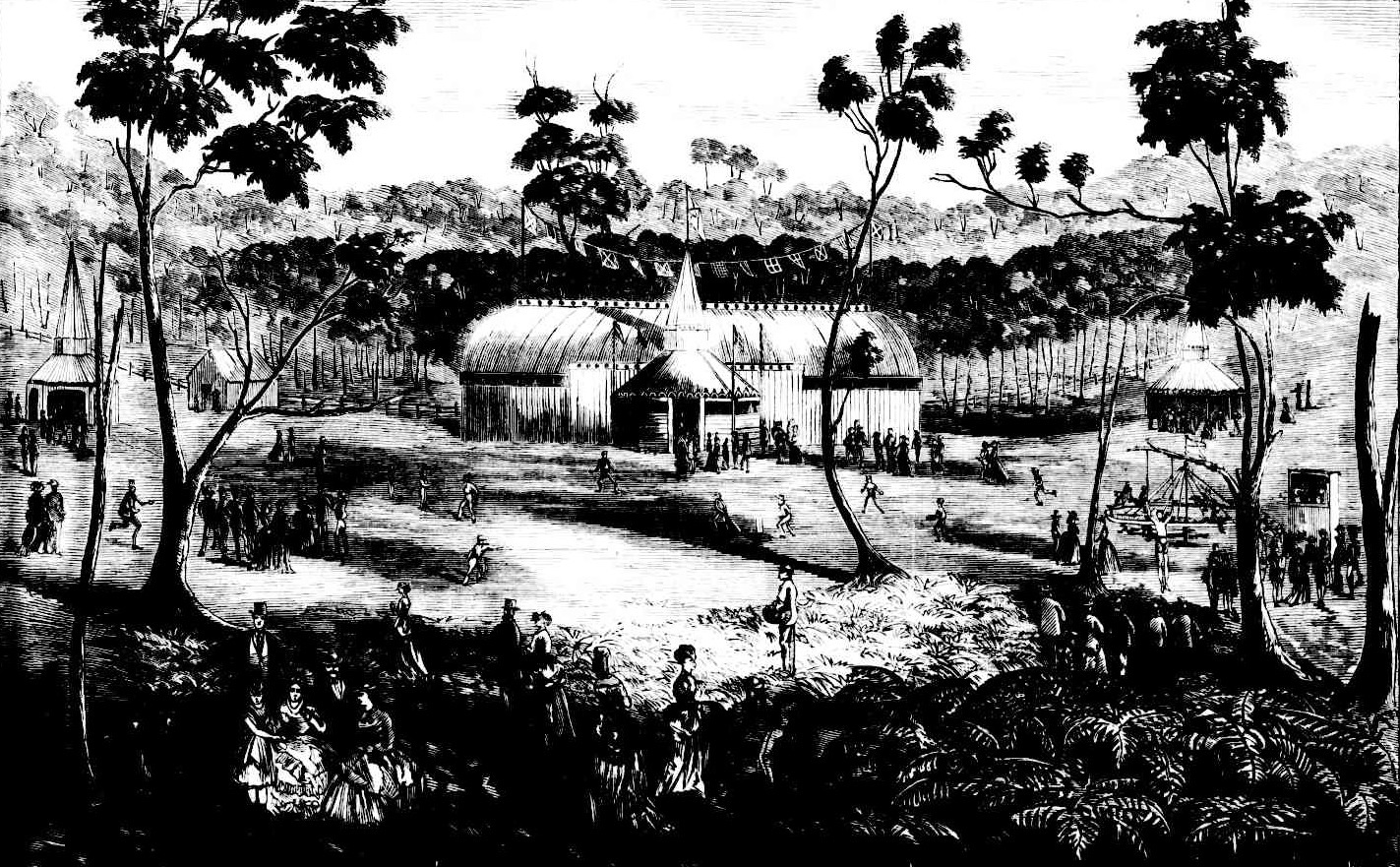
EIGHT-HOUR DEMONSTRATION-PICNIC AT IVANHOE PARK, MANLY BEACH.THE MONTH. (1872, March 19). Illustrated Sydney News (NSW : 1853 - 1872), p. 1. Retrieved from http://nla.gov.au/nla.news-article63618556
This indigenous team had its beginnings in the western district of Victoria, where cricket was played on many stations where indigenous station hands and stockmen employed on those stations began to take part in the game. William Hayman, owner of Lake Wallace station, formed a team of men from three tribes: Jardwadjali, Gunditjmara and Wotjobaluk.
The indigenous players were admired for their athletic skills, and in early 1866, a series of matches were staged with the intention of selecting the strongest possible Aboriginal XI. Thomas Gibson Hamilton of Bringalbert Station, near Edenhope, created a team which he coached. They played an exhibition match at Hamilton, which gained the attention of Tom Wills.
The resulting team was initially coached by local pastoralist William Hayman. Coaching duties were later turned over to Tom Wills, captain of the Victoria cricket team and founder of Australian rules football, who spoke to the team in an Aboriginal language he learnt as a child growing up in the Western District among the Djab Wurrung people. Wills' decision to join and help the team has been a source of intrigue, given that only five years earlier, he survived a massacre in Queensland in which his father and 18 other settlers were murdered by local Aboriginal people. "It was always a matter of wonder how Tom could be friendly with the blacks, considering that they murdered his father", recalled one sportswriter.
With the assistance of Tom Wills, who coached and played for the team, Hayman arranged a match in Melbourne to take place on Boxing Day 1866. While the team was thoroughly beaten by the Melbourne Cricket Club, the match was watched by a crowd of around 8000 spectators.
Bell's Life in Victoria reported:
"Seldom has a match created more excitement in Melbourne than the one under notice, and never within our recollection has a match given rise to so much feeling on behalf of the spectators."
"The veteran Wills never captained an eleven who so thoroughly possessed the sympathies of the spectators," wrote a Melbourne correspondent for The Sydney Mail. "A dark skin suddenly became a passport to the good graces of Victorians."
Although they lost to the MCC, the Aboriginal players were commended for their performance, and showed marked improvement on a subsequent tour of country Victoria.
A trip to Sydney and more matches were arranged as a result of this success and the idea to tour England was born. However, as already stated, while in Sydney the team’s funds were embezzled and they were stranded. Charles Lawrence took over coaching the team and organized a number of games, completing a tour of New South Wales before returning to Victoria in May. Four players succumbed to the effects of illness: Sugar and Watty died on tour while Jellico and Paddy died shortly afterward.
With new financial backers attracted by the money-making aspects of the scheme, the idea of sending the team to England was pursued under the guidance of Mr. Hayman and the coaching of Charles Lawrence. The tour was financed by Sydney Lawyer George Graham along with his cousin George Smith (who had been Mayor of Sydney in 1859) and William Hayman. They all travelled to England for the tour.
In 1867 Lawrence trained the players at "Lake Wallace" in Edenhope in the Wimmera and this report, although inappropriate and offensive to us today in the words chosen to be used, also reflects the how people expressed themselves then, that there was clearly a great fondness for these cricketers. It is included due to its accuracy in recording what was occurring:
CRICKET
THE BLACK CRICKETERS.
(from the Warrnambool Examiner, October 1.]
The effort made to secure the services of Mr Charles Lawrence, one of the original All England Eleven, to captain the team, has been successful, and he left Sydney for Lake Wallace (in Victoria), in July last. The care taken of the blacks by him when they were under his hostelry at Manly Beach, created a favorable impression on the minds of the aborigines and though several fresh men are now introduced, Mr Lawrence has them all under perfect control, and with the aid of Mr W. R. Hayman, who proceeds to England to assist in all matters connected with the affair, they appear like a happy travelling family. The high character borne by Mr Lawrence not only as a good cricketer, but in his social capacity, is a sufficient guarantee that his charge will be well cared for ; and as he has determined to return to the colonies himself, in company with Mr Hayman, he will bring back our sable brethren with hard-earned laurels ; for, if the blacks do not succeed in beating English cricketers, they will certainly astonish Britain in their other games, such as throwing the boomerang, spears and cricket ball, also in running, jumping, &c.
Each man has entered into a written agreement to fulfil his engagement. They have left their tribe at Lake Wallace, on the understanding that they will return at the end of 1868. Two of them, Dick-a-Dick and Twopenny, are married, and Tarpot, who is a great favorite in Melbourne, has for the present not joined the party, because he determined to enter the matrimonial state a few weeks since. It is gratifying to know that the gentleman who has the principal control of the men — we mean Mr W. R. Hayman — has known these blacks for some years, many of them having been brought up on his station at Lake Wallace, and from the urbanity and unobtrusive demeanor shown by him during the former trip of the aborigines, we are satisfied that their comfort and wants will be well cared for and attended to.
The darkies display much gratitude for the kindness exhibited towards them, and as they get good wages, and, best provisions, with needful refreshments, their being entrusted to the care of Messrs Lawrence and Hayman will give the public every satisfaction. Their first match will be played at the New Cricket Ground, at Warrnambool, on Wednesday and Thursday, 2nd and 3rd of, October, and the following day will be occupied in sports, for which the residents have very liberally offered prizes to all comers. On Saturday, they purpose leaving Warrnambool per steamer Barwon, for the purpose of playing a match at Geelong on the 11th and 12th October. From thence they will proceed to Ballarat, Bendigo, and Castlemaine, arriving in Melbourne in time (it is expected) to play before H.R.H. the Duke of Edinburgh.
After the Victorian tour, the aborigines will proceed to Sydney in November, and intend leaving that port for China in December, to play matches in Hong Kong, hoping to arrive in London early in May, in time for the next cricket season. Mr Lawrence purposes leaving England for Melbourne in August, 1868, bringing his compeers with him. The "troupe," consisting of Messrs Lawrence and Hayman, with thirteen aborigines, and a cook and coachman, left Lake Wallace in a large American waggon, drawn by four horses, supplied with tents and 'tucker,' on Monday, the 16th September, 1867, and camped the first night between Harrow and Edenhope, the waggon there having become bogged. On Tuesday, the 17th, the weather being very wet and cold, they left early, and camped at night close to Harrow. On Wednesday the morning was fine, and they proceeded half-way between Harrow and Coleraine, where they camped for the night. On Thursday, camped close to Coleraine, and on Friday half-way between Coleraine and Hamilton. On Saturday morning the party arrived at Trainor's Hotel, near Hamilton, where they were entertained at dinner by the host. A number of the cricketers from Hamilton came out to meet them, with a view of inducing the blacks to play a game at football on Saturday afternoon ; but Messrs Lawrence and Hayman declined, as the Hamiltonians had refused to meet them again in the cricket-field The troupe therefore passed through without making a call, as they were disappointed at the Hamilton Club not wishing to regain the laurels they lost two years since. At night the party camped at Germantown, and on Sunday, the 22nd, passed Mount Rouse, and camped six miles off.
About midday on Monday, in passing Caramut, the following accident occurred :— The coachman being un-well, Cuzens took the reins. He drove the horses in full trot, up the hill, and was thrown off the box on to the hard road, falling with his head on the ground; one of the wheels having come in contact with a large stone; Mr Lawrence who was sitting alongside, was afraid that Cuzens would be killed, but his presence of mind saved him. He rolled himself up in a second, and the wheels just touched his legs only to tear the clothes: The horses were immediately stopped by some of the blacks who were walking on ahead to relieve the horses, and Cuzens, being asked how he felt, replied by saying, 'I think my head is a little hurt'. We are glad to say he is now quite convalescent. They camped at the end of the metal road a few miles from Spring Creek, and on Tuesday, at three p.m. arrived at the Victoria Hotel, Warrnambool, where they were comfortably quartered by Mr Adam Murray. During the trip Mr Lawrence, not having been used to bush travelling, was un-able to get much sleep, though the blacks made him excellent 'wigwams' and had the fire kept up to his toes. The weather was bad, and it rained nearly the whole distance ; glad they were, therefore, one and all, to settle down in a civilised style, in Warrnambool.
Mr Lawrence states that he enjoyed the trip very much the blacks having, been engaged kangaroo and opossum shooting in the evening, and occasionally favoring him with a 'corroboree,' prior to giving the sailors a treat on board ship. The darkies also amused their comrades by "Paine's first set of quadrilles;" with polkas; schottisches, waltzes, &c, finishing up with whist or ecarte. The "corps'' are; now supplied with suitable raiment for their long campaign. The cricketing dress consists of flannel, white trousers, military red shirts with a blue flannel sash sewn on from the right shoulder to the left hip ; added to which are blue elastic belts, neckties of the same color, white linen collars, and French merino undershirts. In these all are, alike, but each man has a separate colored cap with peak as follows: — Mullagh, scarlet ; H.Rose, Victoria plaid ; Cuzens, purple ; Dick-a-Dick, yellow ; Sundown, check ; Redcap, black; ; Mosquito, dark blue; Peter, green; Jim Crow (Neddy) , pink ; Bullocky, chocolate ; King Cole (Charley), magenta ; Twopenny, McGregor, plaid; and Mr Lawrence, all white. Their running costume (for sports) is white tights, and different colored trunks and caps.
In conclusion, we may mention that it is intended to exclude professionals in all matches to be played. Mr. George Smith, formerly Mayor of Sydney, will proceed to London a month before the aborigines leave to make arrangements for their, reception. We are indebted to the courtesy of Messrs Lawrence and Hayman for the particulars above given, and heartily hope that they may have a successful, harmonious and happy trip in their novel and unusually "dark" undertaking. CRICKET. (1867, October 5). Leader (Melbourne, Vic. : 1862 - 1918, 1935), p. 12. Retrieved from http://nla.gov.au/nla.news-article196633699
Another report:
ABORIGINAL CRICKETERS.
A TEAM of aboriginal cricketers made their debut before the Australian public last season, and created a great sensation by their proficiency in the noble game which hitherto has been exclusively regarded as essentially English. After engaging in many contests in Victoria and New South Wales, frequently with first-class clubs, with whom they at least played on equal terms, and frequently came off victorious, they retired for the winter season to their homes at Lake Wallace, Victoria. Since then, the project of giving the darkies a tour in Europe, which, some time previously had been thought of as a possibility, has been matured. Some few months since Mr. Charles Lawrence (once of the All-England Eleven) left Sydney for Lake Wallace to re-organise the band of aboriginal players, and after spending two months in tutoring them, again brought them out at the beginning of this season. There was a marked improvement in their play, and in their engagements they have reaped a large share of the laurels. They started by defeating sixteen of Warrnambool in one innings by 94 runs.
The next engagement, against sixteen of the Mortlake district, terminated in a draw. Thence they proceeded to Geelong, when they played two matches, both of which were drawn on terms honourable to the black players. They now passed into New South Wales, and the first event after their arrival took place at Wollongong, where they obtained a victory over the local players by eight wickets. At Maitland, where last season they were defeated, they now proved victorious, winning a match in which some first-rate players took part, by eight wickets. At Singleton and Newcastle they also won their matches with many wickets to spare.
Although they have the aid of Lawrence it has not been of great service in the way of score-making, as it appears from the records that he has never made more than 15 runs in any match. But to his tutorship and judicious management of them in the field, where he holds them in perfect control, and guides their movements so well that they would form a good example for some of even our crack elevens, may properly be admitted much of their success, although in saying so, it is not intended to ignore the great aptitude for the game that such men as Mullagh, Cuzens, Dick-a-Dick, Rose, and Bullocky display in all departments. It is fortunate that they have been accustomed by their trainers to temperate habits, so that sobriety need not be maintained by constraint. The intercourse of these men with their white brethren seems to have evoked their ambition, and not content with speaking thoroughly intelligible English, are anxious to read and write, and disposed to attend a place of worship regularly.
They are well disposed to pay a visit to England under the care of Mr. Lawrence, to whom they are much attached, and of Mr. Hayman, who proceeds to Europe to assist in all matters of arrangement. If the blacks do not succeed in beating English, cricketers they will certainly astonish Britons in other games, such as throwing the boomerang, spears, and cricket ball, as well as in running, jumping, &.c. Two of them, Dick and Twopenny, are married, and Tarpot, who is a great favourite wherever he goes, has recently entered into the matrimonial state, which will account for his absence from some of this season's matches. Mr. Hayman has known these blacks for years, and his ordinary urbanity of manner, and the kindness he has always exhibited to these men, are a guarantee that their comforts and wants will be attended to satisfactorily.
They are to leave this port for China in November, intending to play at Hongkong, and hoping to arrive in London early in May, in time for the Cricket season. They propose to return in August, 1868. Their cricketing dress consists of white flannel trousers, military red shirts, with a blue flannel sash sewn on from the right shoulder to the left hip. They have blue elastic belts, neckties of the same colour, white linen collars, and French merino under shirts. This is their uniform, but each man has a separate coloured cap. It is intended to exclude professionals from any matches in which they engage. Mr. George Smith, a gentle-men well known in this community, leaves a month before the aborigines, in order to make the preliminary arrangements for this novel and spirited enterprise. ABORIGINAL CRICKETERS. (1867, November 23). The Sydney Morning Herald (NSW : 1842 - 1954), p. 5. Retrieved from http://nla.gov.au/nla.news-article13157345
On their return to Sydney, and before their departure, a display was put on for the first royal visitor to Australia, HRH Albert, at the Albert Ground at Redfern:
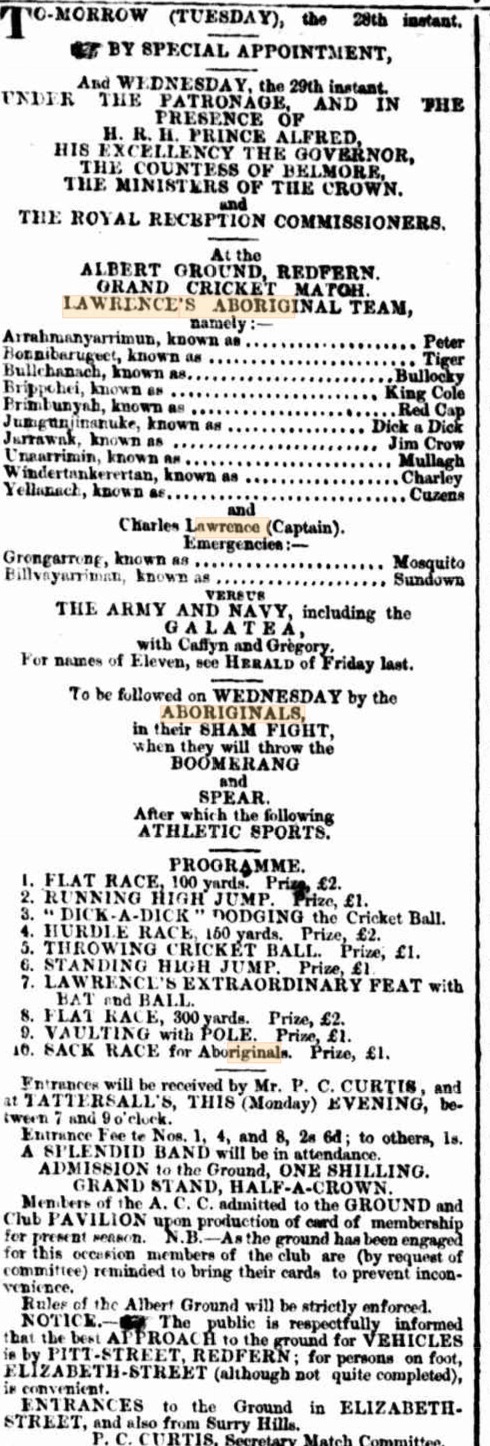
Advertising (1868, January 27). The Sydney Morning Herald (NSW : 1842 - 1954), p. 8. Retrieved from http://nla.gov.au/nla.news-article13155139
The Pier Hotel was already under another proprietor, a J Campbell Sharp:
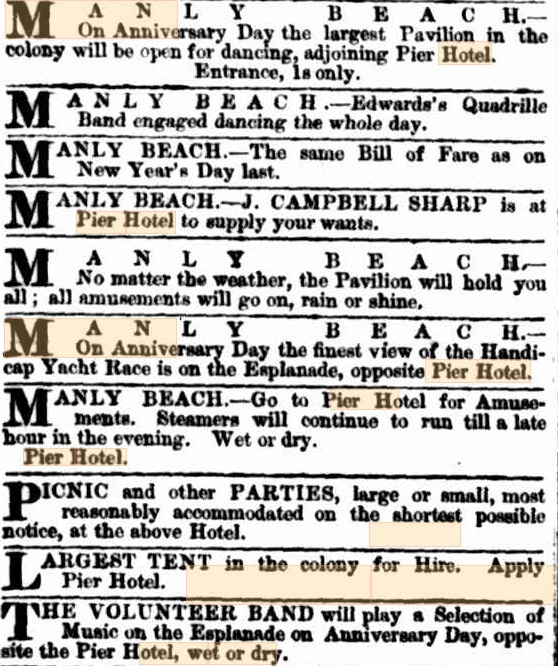
Advertising (1868, January 24). The Sydney Morning Herald (NSW : 1842 - 1954), p. 8. Retrieved from http://nla.gov.au/nla.news-article13155198
The team left Sydney in February 1868. This was the first time an organised sporting group had travelled to England as representatives of Australia.
That Tour of England team is listed as:
- Charles Lawrence – Captain /Coach
- Johnny Mullagh – traditional name: Unaarrimin
- Bullocky – traditional name: Bullchanach. A wicketkeeper, Bullocky was referred to as "at once the black Bannerman and Blackham of his team".
- Sundown – traditional name: Ballrin
- Dick-a-Dick – traditional name: Jungunjinanuke
- Johnny Cuzens – traditional name: Zellanach
- King Cole – traditional name: Bripumyarrimin
- Red Cap – traditional name: Brimbunyah
- Twopenny – traditional name: Murrumgunarriman
- Charley Dumas – traditional name: Pripumuarraman
- Jimmy Mosquito – traditional name: Grougarrong, who "could walk upright under a bar and then jump it in a stander".
- Tiger – traditional name: Boninbarngeet
- Peter – traditional name: Arrahmunijarrimun
- Jim Crow – traditional name: Jallachniurrimin
After arriving in May the team was subjected to a gruelling schedule, playing 47 matches against intermediate-level English amateur teams between May and October 1868. The Australians surprised their competitors with their sporting prowess, winning 14, losing 14 and drawing 19 of their 47 matches.
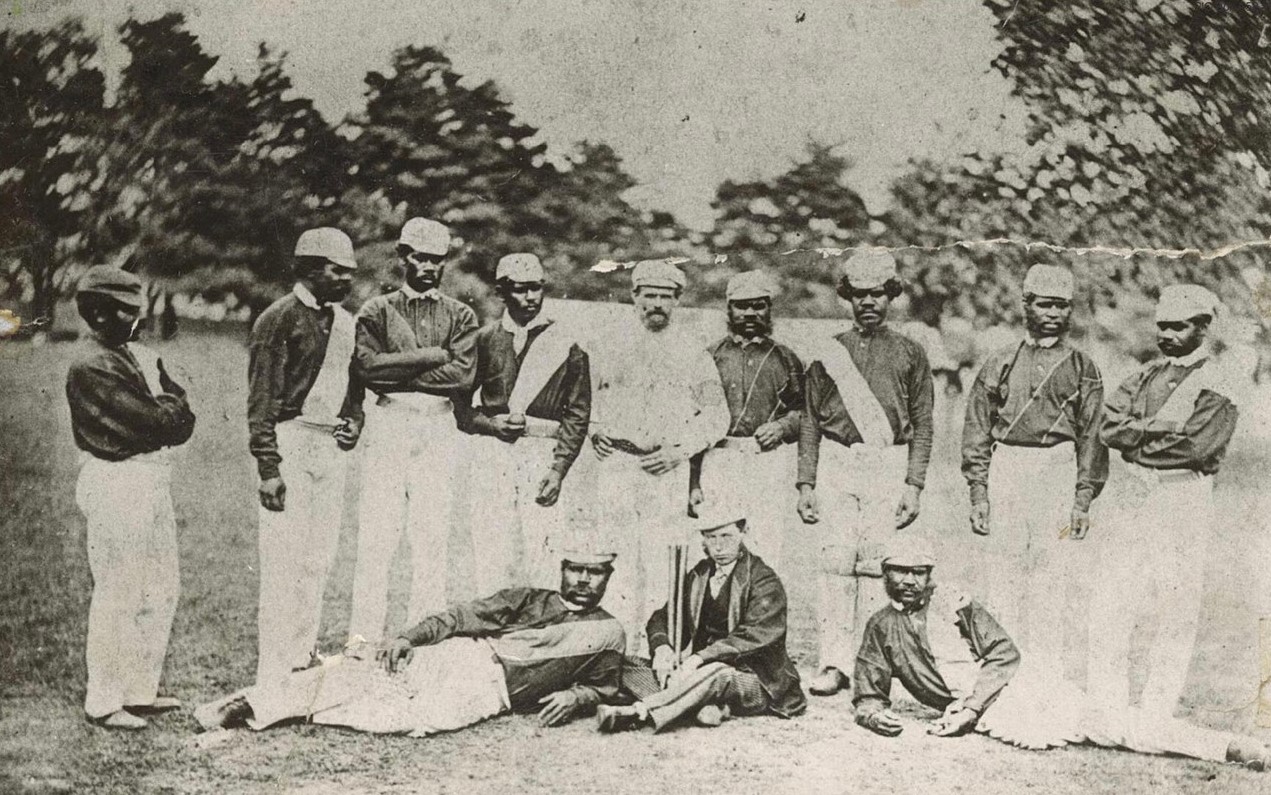
Lawrence's team of Aboriginal cricketers with Lawrence and William Shepherd, who helped manage and umpire the XI, on tour in Swansea, 1868. Image courtesy State Library of NSW.
Unaarrimin, a Wotjobaluk man also known as Johnny Mullagh, was the standout performer. An all-rounder, he scored 1698 runs, bowled 1877 overs – 831 of which were maidens, and took 245 wickets. He also achieved four stumpings while playing as wicketkeeper.
The team also performed a range of ‘traditional’ sports and displayed skills such as boomerang and spear throwing. One member of the team, Jungunjinanuke, also known as ‘Dick a Dick’, used a club and shield to deflect and dodge cricket balls hurled at him by volunteers. These ‘Aboriginal sports’ often drew large crowds due to their novelty and the players’ skill.
The tour provoked mixed reactions from the English public and media. The Times described the tourists as ‘the conquered natives of a convict colony’ and a ‘travestie upon cricketing at Lords’. Questions about the civilising aspects of cricket, the intentions of the organisers and the skill of the players were raised.
The matches were well attended by a curious public though, with the first event at Surrey’s home ground, the Oval, drawing 20,000 spectators.
Tragically, during June, King Cole died from tuberculosis and was buried in Victoria Park Cemetery in what is now Tower Hamlets in London. Sundown and Jim Crow went home in August due to ill-health.
On their return to Australia, most of the cricketers returned to station life.
In 1869, the introduction of the Aboriginal Protection Act in Victoria, which removed people from their traditional home grounds and corralled Aboriginal people onto reserves, required signed permission from the Protector of Aborigines for them to leave. This made it difficult for Indigenous cricket players to continue playing competitive cricket and denied both them and the rest of Australia the great sportsmanship and conversations that had commenced taking place.
As we say here ''it's just not cricket''! (Australian and English term first used in 1851: Having something that is unjust or just plain wrong done to someone or something. This came from the game of cricket which is regarded as a gentleman’s game were fairplay was paramount.)
Unaarrimin, however, continued to play cricket and represented Victoria against a touring England side in 1879, top scoring with 36 in the second innings. The Johnny Mullagh memorial trophy is named in his honour and the Johnny Mullagh Cricket Centre has been established in Harrow, Victoria.
A poster was produced as part of the promotion of the 1868 tour that depicted each of the players and managers. The photographs were taken by Patrick Dawson at his studio in Warrnambool and assembled into a composite picture that he issued in a slip-case as a souvenir.
The composite photograph was lithographed and the resulting poster, Australian Aboriginal Cricketers, is embellished with decorative scrolls, a coat of arms, boomerangs, spears, a bat and stumps.
.jpg?timestamp=1643347453849)
Photo collage by Peter Dawson to promote the 1868 Aboriginal cricket team tour. Image: courtesy National Museum of Australia.
Each of the Aboriginal players is identified and is shown either in a traditional cricket stance or holding an Indigenous weapon, such as a boomerang or a spear. This depiction hints at the dual sport and entertainment purposes of the tour. It also suggests the cultural cross-over between the players’ Indigenous heritage and the learned skills of cricket.
On his return to Sydney Mr. Lawrence moved up the coast to Newcastle where he worked for over two decades as an official for NSW Railways. Here, aged 55, he played for XVIII of Newcastle v Ivo Bligh's 1882/83 tourists. Mr. Lawrence also coached the juniors of the Melbourne Cricket Club from 1891 for between five and eight years.
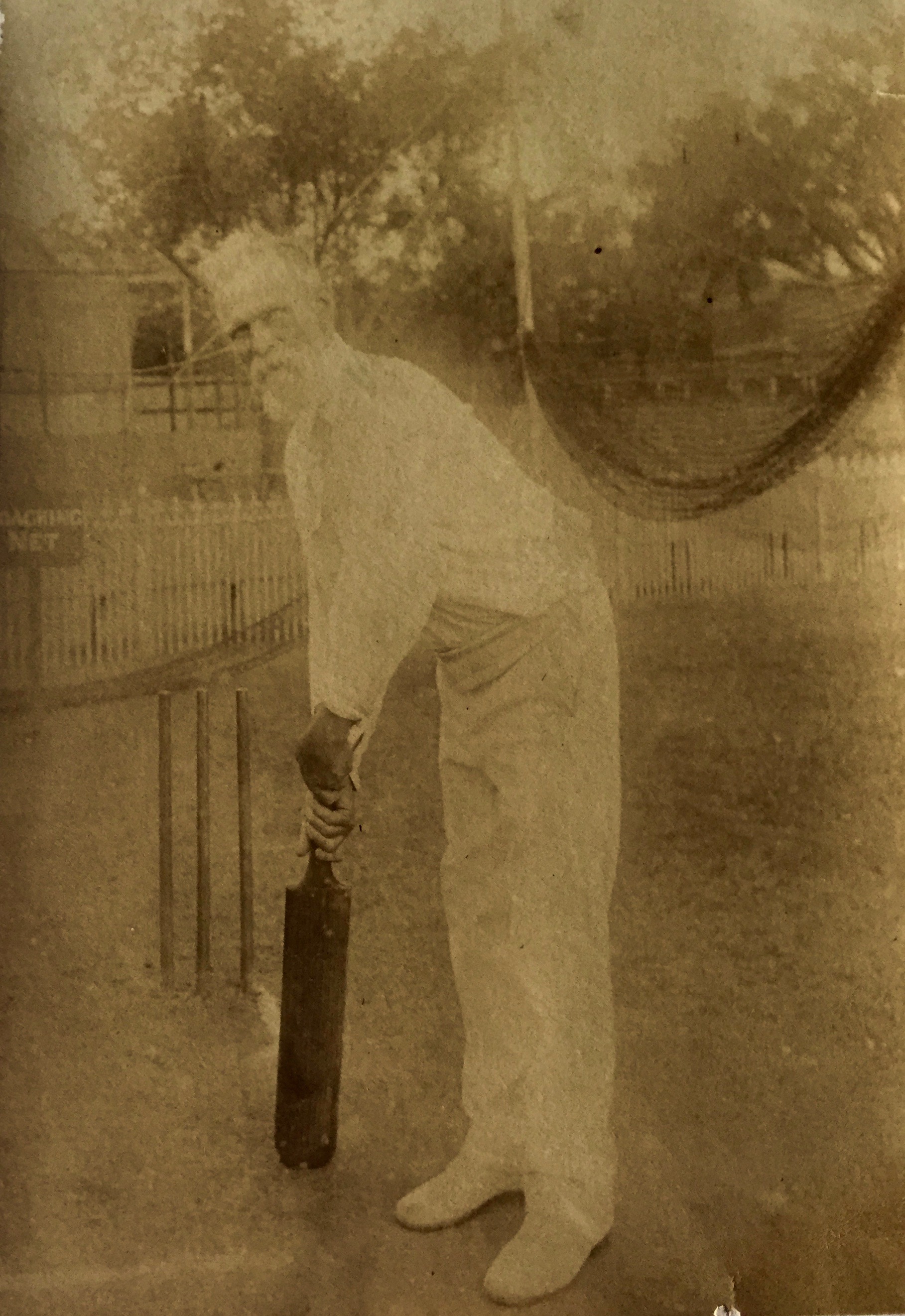
Charles Lawrence at Melbourne Cricket Club. 70 year old Coach! Photo: Lawrence family album
When he passed away in January 1917 he was stated to be the 'Father of Australian Cricket' in some tributes. One example:
Death of Mr. Charles Lawrence
One by one the old order of players, the men who were in at the birth of the game in this country, are passing away, until very few are now left. Within this class Mr. Charles Lawrence, who died in Melbourne on Saturday, might be included, though he did not come out from England until 1862, when he was one of the historic team, brought along by H. H. Stephenson to make money for Spiers and Pond, and lay the foundations of the game in the land of the Golden Fleece.
William Caffyn, still alive in England, is now the sole surviving member of the team.
Charles Lawrence settled in Sydney at the close of the 1862 tour, and played for New South Wales from 1863 to 1870, taking part in five matches against Victoria. He averaged 10.22 in nine innings, and secured 25 wickets at an average of 10.84. Caffyn did not settle in Australia until after he had come out again with George Parr's team in 1864.
These men came to this country some years before the writer was born, so that one had no opportunity of seeing them playing. But I had the pleasure of meeting Charles Lawrence more than once, the last occasion on his last visit to Sydney a few years ago when England was playing Australia at the Sydney Cricket Ground. He was then a wonderful man for his years, quite active in his gait, and as keen in mind as a man of 30. I was struck by his alertness in summing up the players of the moment, by the excellence of his judgment, and his modesty. He was a small, wiry man, and you could see that he had been a trier on the cricket field.
To quote Caffyn: 'Lawrence was a Middlesex man by birth, but through residing at Mitcham became qualified for Surrey, for whom he played a few times. Then he went to live at Edinburgh for a few years, and afterwards crossed over to Dublin, where he became secretary of the United All-Ireland Eleven. He was a fast bowler, and a good bat, though not a powerful hitter. He was, besides, an excellent judge of the game— one of the best in fact I ever knew. He was a light man of medium height.' The foregoing are the views of his great Anglo-Colonial contemporary, and he gave me a similar impression' when I met him as an old man.
Caffyn tells of an experience Lawrence had when playing with Stephenson's eleven. At the conclusion of the match with 22 of Bendigo, Lawrence played one of the Bendigo men at single wicket, allowing his opponent the privilege of 11 fielders. They had two innings each, and scored no runs at all. Luckily for Lawrence, his opponent bowled a wide, which caused him to win.
When George Parr's team visited Australia in 1864, Lawrence, who had been coaching in Sydney since 1862, played with the New South Wales 22 against them, and scored 25 out of the first innings total of 137. In the third match against the Englishmen Lawrence bowled splendidly, getting six wickets very cheaply in the second innings. The finish to the match was very exciting, the Englishmen winning by one wicket, amidst what Caffyn records as indescribable excitement.
In 1868 Lawrence accompanied the aboriginal cricketers to England, and toured with them everywhere. He was with them also in the few preliminary matches in Australia. In discussing the phenomenal improvement of Australian cricket in the two years between the visits of the teams of 1862 and 1864, and also up to the time he left Australia in 1871 on his return to England, Caffyn paid a tribute to his old comrade-in-arms when he wrote: 'I must take this opportunity to speak of the good work done toward the development of Australian cricket by Charles Lawrence, who by his per-severance, energy, and ability did a great deal toward the raising of the game to its present high standard. Altogether.it is very pleasant to me, as a Surrey man, to remember that my native county has been so closely connected with Australian cricket in its infancy. It was owing in a great measure to Mr. Burrup's (secretary of Surrey County) energy that the first English visit there did not fall through, and it fell to the lot of two Surrey players to be the first instructors of the game in the Colony.'
Charles Lawrence was born on December 16, 1828 so that he had completed his 88th year. One of his sons, bearing the same name, was a successful performer in Newcastle over 25 years ago, but he went to America, where, I believe, he died. William Caffyn will be 89 years old the first week in February.
Sketch of his career In my scrap-book the following sketch of the . career of Charles Lawrence appears. I can-not trace the newspaper from which it was taken, but the old man himself in 1898 told me that the facts were correct: —
The celebrated veteran of the first All-England Eleven that visited Australia will at the close of this season (1898) retire from his post of coach to the Melbourne Cricket Club. Charlie Lawrence was born at Oxten, Middle-sex, on December 16, 1828, and when very young moved to Merton, in Surrey. Thus he played for both counties. His career in the: cricket field commenced at the age of 17, by an engagement with the Perth Club in Scotland, which included in its members Sir Thomas Moncrief. Lord Duplin and several other noble-men. Their great yearly contest was a home and home match with the Grange Club, Edinburgh.
The first visit of the All-England Eleven to Scotland was on May 7, 1849, and on the Grange Ground, for 22 of Scotland, Lawrence took the whole of the English wickets for 24 runs. In 1851 he was engaged by the Phoenix Club, Dublin; and on July 23, 1856, was appointed cricketer to his Excellency the Earl of Carlisle, Lord Lieutenant of Ireland. In 1859 he filled a similar post under the Earl of Eglinton, Lord Lieutenant of Ireland. In 1856 he formed the United All-Ireland Eleven, and acted as its secretary and captain.
In 1861 he was a member of H. H. Stephenson's All-England Eleven; and in 1862 was engaged by the Albert Club in Sydney. In 1868 he trained and took to England the aboriginal team, and after his return entered the service of the New South Wales Government, where he remained for 24 years, retiring at the age of 63 through ill-health.
Shortly after leaving the Public Service in New South Wales, the veteran's skill as a coach was availed of by the M.C.C, and for the past six years he has given every satisfaction in that capacity. He is now in his 70th year, and has made up his mind to give up active cricket. In consideration, not only of his long connection with Australian cricket, but also of his personal worth, the M.C.C. have granted him the . use of their ground on Easter Saturday and Monday for a benefit match, which will be be-tween eleven or fifteen of players he has coached, and eleven to be chosen by the Victorian Cricket Association. The death of Norman Dodds, the Tasmanian cricketer, at Hobart, adds to the long list of Australian cricketers who-have passed out while still young men. It is astonishing how many have died within the last few years. Dodds was a fine wicket-keeper and a good bat. He was expected by many to win a place in the last team which visited England, but the selectors did rot' deem his qualifications good enough. He batted ably in a trial match in Melbourne, but the place in the team did not come to him. He was a son of the late Chief Justice of Tasmania. Death of Mr. Charles Lawrence (1917, January 10). Referee (Sydney, NSW : 1886 - 1939), p. 12. Retrieved from http://nla.gov.au/nla.news-article120292813
His passing also revived memories and reports of that first ever Australian XI Tour to England:
THE BLACK CRICKETERS.
A FORGOTTEN TOUR.
By DONALD MACDONALD.
The death of that fine old cricketer of early international fame, Charles Lawrence, recalls one or two unusual incidents in the story of Australian cricket. Lawrence was not only a member of the first team of English cricketers that came to Australia, but fifty years ago was a member of the first Australian eleven that visited England. No team was ever better entitled to the term Australian, because, with the exception of Lawrence, who coached and afterwards captained them, they were wholly aborigines.
It was in 1865, I think, that the idea of taking a team of blacks to England was first mooted, and in 1866 they played a Victorian team—with the cracks of the day ex-cluded—on the Melbourne Cricket-ground, but the English tour came off some 18 months later, in 1868. W. R. Hayman, of Edenhope, was the first to suggest it, and the team was chosen wholly from that area about the watershed of the Glenelg, which, after fifty years of development, is still largely pastoral country, with Edenhope, Harrow, Balmoral, Casterton, and Coleraine as its centres. Playing with local clubs, Mullagh and Cuzin had already won some distinction—this pair were in all-round capacity not only the backbone of the side, but some of the ribs as well.
The blacks of the plains country about the South Australian border were rather a better type than the coastal tribes, considerably taller, though scarcely so thick-set, with less of that flatness of countenance which disfigures the aborigine as a race. "Mullagh," the Black "W.G." of the team, was a superior man in many ways. He had all-round capacity in cricket, with something of a personality to back it. He was remarkably abstemious for a black, had that sense of self-respect equally rare with them, never spoke pidgin English, and quietly professed not to understand it when someone sought to air his knowledge of the bush and the blacks by using it. He has been not extravagantly described as one of nature's gentlemen. Yet he had in a very pronounced form one unalterable quality of the aboriginal race which seriously affected his success as a cricketer—ineradicable indolence. In every innings he played his strokes would have meant one-third more runs to an active white batsman. The boundary hit had a special appeal to him, not so much in that it counted as because he got the 4 without running for them. Yet one has only to glance at the results of the tour to see that for Mullagh and Cuzins especially the series of 47 matches played in England—of which 14 were won, 14 lost, and 10 drawn—must have been particularly tiring. Had this black team been chosen from all Australia it would have been a stronger side, but originating in Edenhope it was largely local.
The names suggest that its members had been much in association with white men. Mullagh look his name, I think, from Mullagh Station, owned by the Fitzgeralds, who were much interested in him. Cuzins got his name as well as much of his knowledge from a firm of Balmoral store-keepers. Charles Dumas no doubt came by his in much the same way-the others were indebted to irregular baptism of a not very original kind, since it seems to be common to the black races, whatever part of the world they inhabit. On the names they might have been the original Georgia Minstrels. Such are King Cole, Bullocky, Jim Crow, Dick-a-dick, Mosquito,Tiger, Sundown, Tuppeny. Red Cap, Charlie, and Peter. As a rule most of the blacks took the surname of a family with whom they lived for any length of time.
They opened their English tour at Kennington Oval, where, amongst the team opposing them, were at least two notable names in those of Jupp-who afterwards came to Australia-and I. D. Walker. Mullagh struck his form in the first game, getting 73 in the aborigines' second hand; and the innings was described as being worth at least a hundred, for they at once noticed Johnnie's aversion to hard running. Amongst white players there have been notable examples of men who never took risks for the other fellow's hit, but got all that was going for their own. Mullagh was impartial and unselfish in this respect. He would run just as slowly for himself as for his partner. With 94 as his highest score in England, he averaged over 23 for 71 innings, while Cuzins had an average of 19 for 72 innings. All Mullagh's powers were in his wrists-he never seemed to use force in his strokes, but trusted to wrist work and exact timing. In style, Bullocky looked one of their best bats, but he had one white failing-he liked to stay in for a long time whether he got runs or not; so Bullocky's average for the tour was only 9 per innings. Years afterwards I met Bullocky-or a black who professed to be Bullocky, and whose bulk answered the description-on the Murray, where he sometimes played. with the Corowa team. It was a wet day-wet for Bullocky in more than one sense. The big black had fallen face forward on the road. Three dabs of mud, on forehead, nose, and chin, illuminated him as if for a corroboree. He passed me obvious compliments upon my skill as a cricketer-compliments which the club score-sheet did not always confirm. The end and object came in the call of the wild all the world over-"Chuck us a bob."
As a bowler upon that tour Mullagh, who was medium pace, right arm, took 245 wickets at a cost of 10 runs apiece. Cuzins had 114 wickets at 11 runs apiece, and the third all-round star of the organisation was the white captain, Lawrence, who in batting averaged 20 for 57 innings, and took 250 wickets at 12 runs apiece. Only two of the blacks averaged 10 or over with the bat. Tuppeny and Redcap did something in bowling-Tuppeny with 37 wickets at 7 runs apiece. Redcap with 54 at an average of 10 runs. Their fielding was always good. Mullagh at his best was almost as good a bowler as batsman, and on one occasion took five of the Warrnambool wickets for one run.
In England the calibre of the side, apart from the few, was soon realised, and no very strong team was sent against them. The progress of the games was a good deal interrupted by exhibitions, such as spear and boomerang throwing, a novelty to Englishmen, though Lawrence expressed the view afterwards that straight-out cricket would have served them best. One of the cleverest of their feats was that of Dick-a-dick, with the aboriginal war shield, called a Kumnal in the West. The shape of the shield is pretty well known-oblong, concave, 3ft. in length, perhaps 6in. wide in the centre, and tapering to points at either end. Stationed 15 or 20 yards off, and holding the shield forward with the one-handed centre grip, he allowed three or four of his opponents in each match to throw cricket balls at him as hard and fast as they pleased, stipulating only for a throw "on The full"-not a grounder. Standing almost as still as a statue, and with a twitch or flick of the shield, he turned the ball off his body as a batsman would glance it to leg. It was a remarkable exhibition of eyesight, dexterity, and coolness, yet, with it all Dick-a-dick was not a prominent batsman. He was evidently using the wrong implement in a bat. Not less remarkable than his skill in turning the straight throw was his judgment in picking the ball that would miss. Very often they almost brushed him. With provoking deliberation and coolness, leg, arm, or head were moved a few inches to one side to let the ball go whizzing by. A peculiarity of the whole team as batsmen was their helplessness with slow bowling, even the simplest of underhand lobs, such as W. H. Handfield sometimes bowled for the M.C.C., getting them out. It seemed to be a weakness peculiar, not only to this team, but lo the whole aboriginal race, whose spearmen can, as a rule, hit a running mark better than a stationary one. On one occasion a pretty good Corranderrk eleven went to Warrnambool, and Frank Allan, who knew blacks well enough to bowl nothing at them but his famous, slow "googlers," took the ten wickets for 11 runs. In the second game Frank stood out, and the aborigines scored , heavily against the Warrnambool fast bowlers, and won the match.
Years after this tour, when Lord Harris brought his English team to Australia, Mullagh played for Victoria against them and scored 33. The baleful off theory had just been introduced, and when the black champion stood back to the first of them from Tom Emmett, the M.C.C. ground rang with laughter and cheers. The hat was sent round, and for that innings Johnnie got £50. He is buried in Harrow cemetery, where the sportsmen of the West put a memorial over his grave.
To Lawrence, especially, the tour was not altogether a pleasure jaunt. Restraint was irksome to the blacks ; the family somewhat difficult to manage, To, save them from English hospitality they were sent to bed early, but it was often a case of in by the door and out by the window. Tiger, a convivial spirit, was arrested and fined for at-tacking a policeman. Public opinion in Victoria was rather against the undertaking. There was a feeling-which members of the Aborigines' Board shared-that it might prove a better thing for the pro-motors than for the blacks, and in the end they were practically smuggled out of Victoria. After a game played at Queenscliff they went out in a yacht, professedly on a fishing excursion, and were picked up by the Rangitira on her way to Sydney. Before the tour was long in progress, Sundown and Jim Crow were sent home ill, and King Cole died in England. THE BLACK CRICKETERS. (1917, January 13). The Argus (Melbourne, Vic. : 1848 - 1957), p. 6. Retrieved from http://nla.gov.au/nla.news-article1590374
When enjoying your cricket this Summer, whether playing or simply watching, it's worth remembering what occurred at Manly 155 years ago this February and, despite the loss to Australia of these excellent sportsmen through strange legilstaed acts, this last account shows these were phenomenal cricketers who clearly inspired locals to commence their own teams and so begin the long history of enjoying this brilliant game in our area.
Simply: it just IS Cricket!
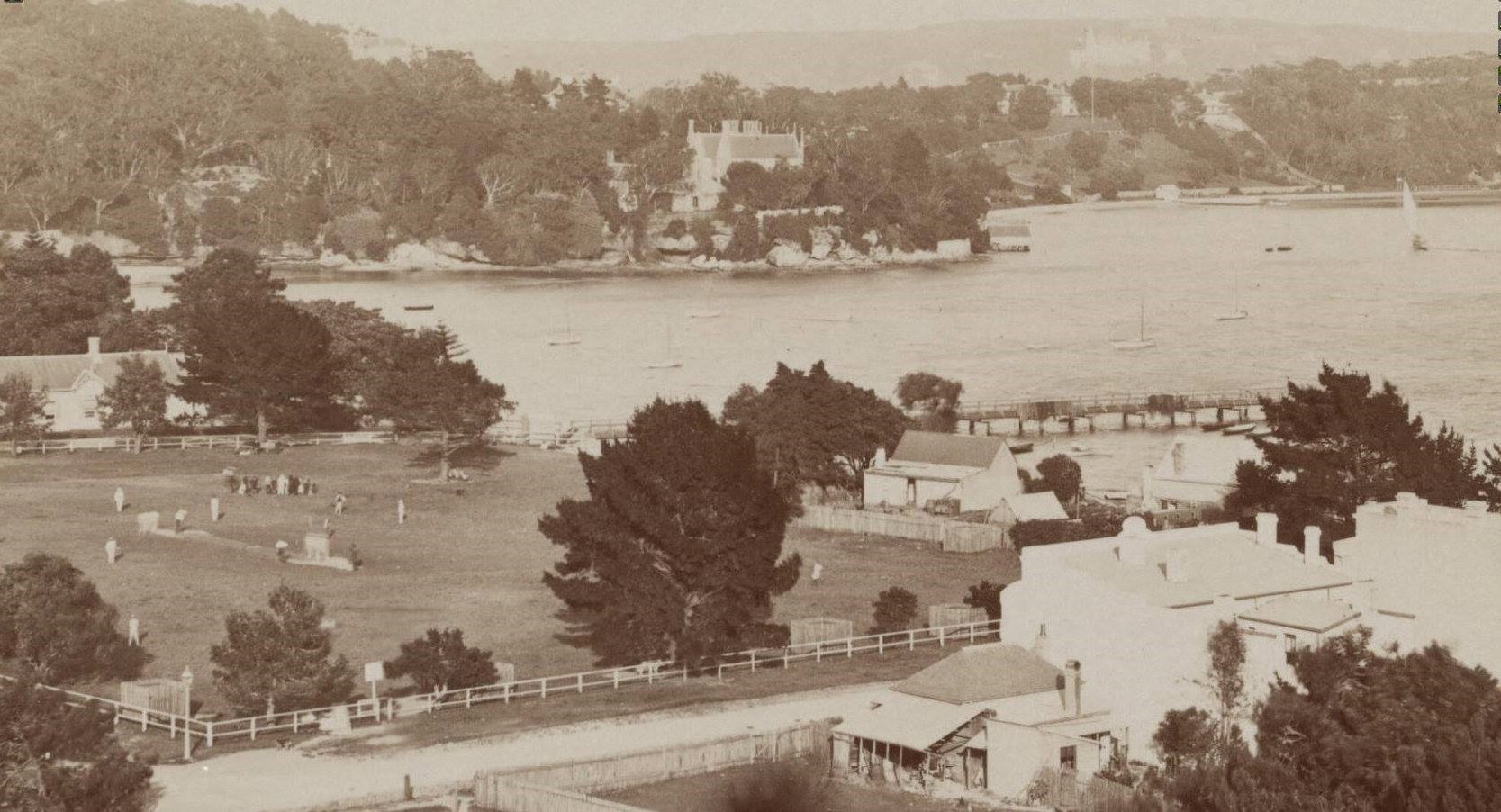
View over a cricket match towards Fairlight House and Cardinals Palace, Manly. Courtesy National Library of Australia, 1895, by Charles Bayliss, from http://nla.gov.au/nla.obj-141507260. Zoomed in to show detail. NB: Author of page has 'flipped' this plate glass photo as digitised by NLA to show correct position of Cardinal's Palace setting on hill in distance.
references and extras
- Manly records - Manly Library local studies librarian John MacRitchie
- TROVE, National Library of Australia
- Aboriginal cricket team - National Museum of Australia
- Manly's Stone Kangaroo, Camera Obscura, First Maze And 'Chute' - Fun Days In Sea Hazes From 1857 On
- Shopping And Shops In Manly: Sales Times From 1856 To 1950 For A Fishing Village
- The First Royal Visitor To Australia: The Incident At Clontarf - March 12th, 1868
- Ivanhoe Park Notes in Boy Scouts - The Pre-Nippers Life Savers: Some Notes On Local Troops From 1909
When Lawrence sailed for Australia with Stephenson, he and his wife Anne had a son and two daughters, all Dublin-born. The family joined him in Australia, but his wife Anne died at the Pier hotel in November 1866. Five days later, their Sydney-born daughter also died.
MANLY BEACH - This favourite place of public resort on holidays was visited yesterday by a large number of pleasure seekers The steamship a Kiama, Breadalbane and Phantom, were chartered, and continued running throughout the day of using the list trip from Manly shortly after dusk. The Iarge saloon at the Pier Hotel was thrown open for dancing, and for which a band was in attendance, leaving nothing, to be desired the votaries of the scheme The chief feature the day' s fun, however, was the sports under the auspices of Messrs Lawrence and Brown, all of which were entered into with zest, while some caused a considerable amount of merriment among the spectators. Prizes were awarded to the successful competitors in each instance. DOWN THE HARBOUR. (1866, April 3). The Sydney Morning Herald (NSW : 1842 - 1954), p. 5. Retrieved from http://nla.gov.au/nla.news-article13128927
LAWRENCE-October 28th, at her residence, Pier Hotel, Manly Beach, Mrs. Charles Lawrence, of a daughter. Family Notices (1866, October 31). Empire (Sydney, NSW : 1850 - 1875), p. 1. Retrieved from http://nla.gov.au/nla.news-article60601742
DEATHS. On the 18th instant, at the Pier Hotel, Manly Beach, MAUD MARY ALICE, infant daughter of CHARLES and ANNE LAWRENCE, aged 5 weeks. Family Notices (1866, November 29). The Sydney Morning Herald (NSW : 1842 - 1954), p. 1. Retrieved from http://nla.gov.au/nla.news-article13145827
His eldest daughter Anne may have accompanied the team to England in 1868, as she is recorded as being with them on the return voyage. In 1871, he married again, to Yorkshire-born Emmaretta Denison. They had three daughters, two of whom died in infancy. Emmaretta was to die before her husband, in hospital, in December 1915.
Lawrence died in December 1916. His death notice reads "The Father of Australian Cricket tours".

View of Manly Beach—" The Pier". (1876, January 29).Australian Town and Country Journal (Sydney, NSW : 1870 - 1907), p. 20. Retrieved from http://nla.gov.au/nla.news-article70588529
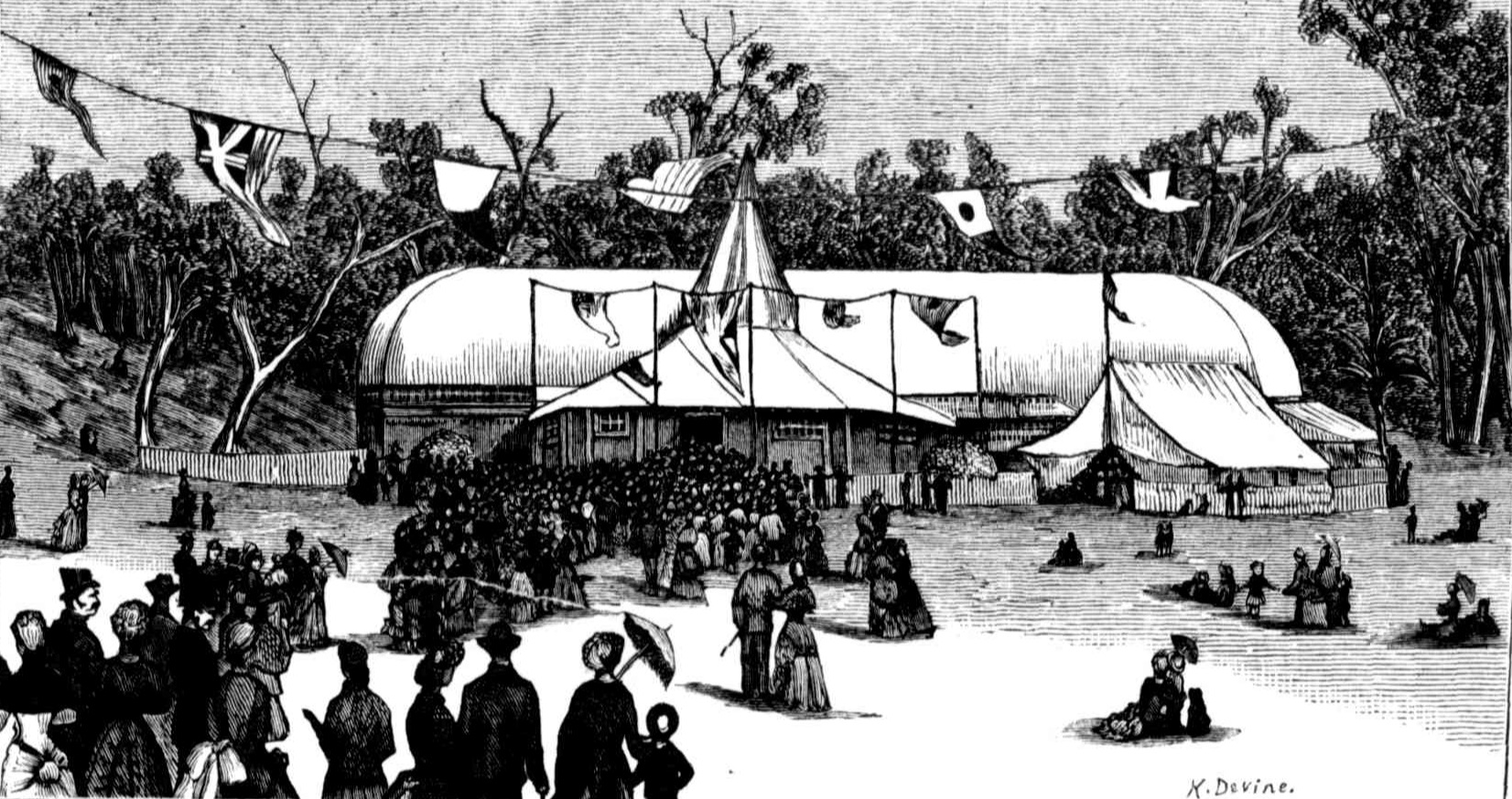
Sketch from Manly Wildflowers Show of September 1883 - report shows the pavilion and original hotel in Ivanhoe Park, Manly
A match was played at Manly Beach on Saturday last between the St. Leonard's C C. and Manly CC., which resulted In favour of the latter by 10 runs.
Appended is the score :
.jpg?timestamp=1643345449377)
A match was played at Manly Beach on Saturday, the 18th instant, between the Manly C. C. and an eleven gentlemen from Sydney, captained by Mr. F. Isaacs, which resulted in favour of the former in one innings and twenty-five runs to spare. Appended is the score :
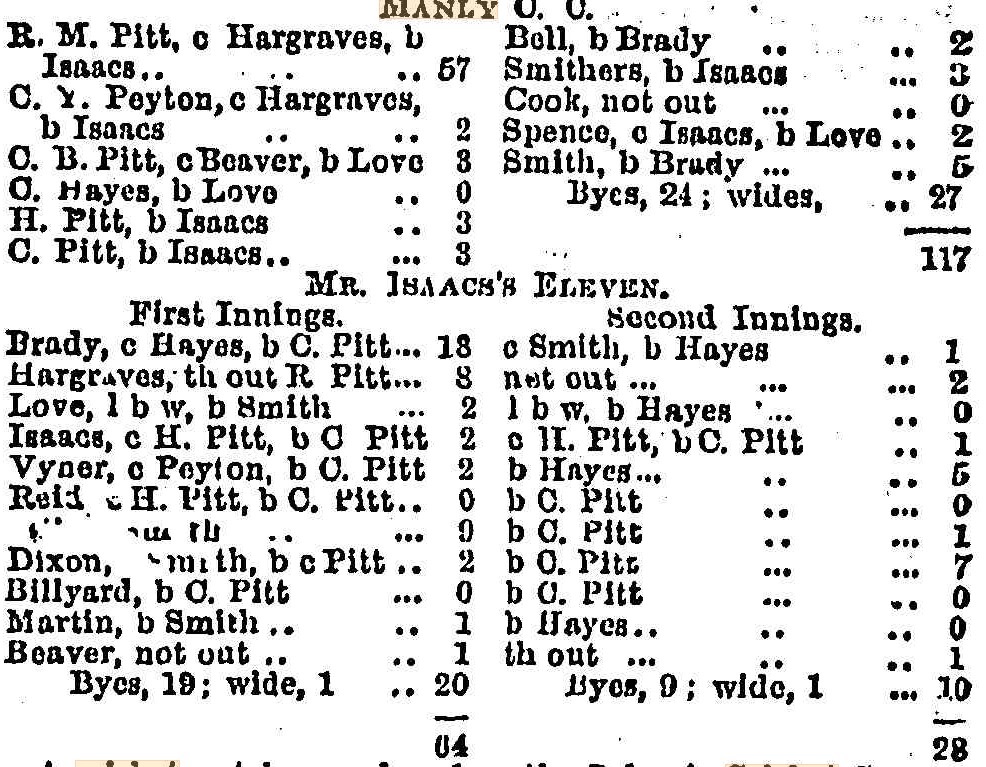
Cricket. (1871, December 2). Australian Town and Country Journal (Sydney, NSW : 1870 - 1919), p. 25. Retrieved from http://nla.gov.au/nla.news-article70470530
MANLY BEACH C. C. v. 2ND ELEVEN OF EAST SYDNEY C. C,-The 1st and 2nd elevens of the above clubs played a match at Manly Beach last Saturday, and which resulted In an easy victory for the local club. The East Sydney scored 80 in their first, and made 20 in their second innings for the loss of two wickets. The Manly Beach eleven scored 110 in
their first innings, out of which number R. Pitt contributed 54, H. Pitt 14, the sundries being no less than 23. Cricket. (1871, December 9). Australian Town and Country Journal (Sydney, NSW : 1870 - 1919), p. 26. Retrieved from http://nla.gov.au/nla.news-article70470683
CRICKET.
THE MANLY CLUB.
The members of the Manly Cricket Club held their annual meeting at the Pier Hotel last night Dr. D. Thomas,. president of the club, occupied the chair, and there was a splendid attendance. The report, as read by the secretary (Mr. J. H. Sanderson), notified that a gratifying increase of playing members had taken place last year— three teams taking the field' '
During last season, a new wicket had been, laid down in Farrell's Park, which will prove of great benefit to members in the future. The committee have entered into arrangements with the council to take over the control of the oval. In the New South Wales Association's Badge Matches, the A team had run- third, being beaten by Balmain by a point. The eleven had won 9, lost 3, drawn 1, and abandoned 1. j F. Row played five innings for 164 runs, and was top of the batting list, with an average of 41.0. Frank Ridge, was next, with 34.5 for eleven innings. The last-named player was the only one to make a century for Manly in electorate matches. Stan. L. Ridge was top in the bowling with 13.03; W. Fraser was next with 13.26, and E. H. Stoney , 13.22 third. The veteran team had a good season. 1 A. Hayes came out best with the bat; while Fred. Lawler outdistanced his confreres with the ball, j on two occasioning the hat trick. The B team for a first y had done exceptionally well — 31 ' matches had been played, 11 won, 10 lost, and 10 ' drawn. The best batting during the season was shown by C. Whiddon, P. Low, G. Stephenson, ;M'Kenzie, and C. Plomley. In bowling, Low, Woods, Whiddon, and Patterson were most successful. The report of Mr. L. H. Wyatt, secretary of the Wednesday team, notified that the team had been a social success; 19 matches had been played, 9 won, 5 lost, and 9 had been drawn. The reports were adopted.
The meeting endorsed the committee's action in taking over control of the oval from this season in conjunction with other athletic clubs. It was decided to enter two teams in the electorate competitions next year. The office-bearers for season were elected as follow: Patron, Mayor of Manly (Alderman W. H. Fletcher); president, Dr. D. Thomas; vice-presidents, Mr. Dugald Thomson, M.L.A., Aldermen O. Carroll, E. W. Quirk,. H. E. Stephenson, A. Russell, F. C. Passau, J. B. Meyer, A. A. Keenan, J. Walker, and Messrs. W. H. Whiddon, C. R, Austin, J. J. Calvert, W. A. Lipscombe, Thos. Wedderburn, J. . Woods, J. Hanson, A. B. Crew, E. Badmington, G. Hole, C. Freeman, F. T. Smith, J. D. Pattison, C. A. Lawrence, and Dr. Henry; hon. secretary, J. H. Sanderson; hon. treasurer, H. D. L. Woods; delegates, E. W. Austin and J. H. Sanderson: selection committee A team, 'W. H. Whiddon, Frank Ridge, and F. Row; general committee, E. W. Austin, F. W. Mannell, F. Ridge, W. Hunter-Smith, F. W. Watson, and E. Percy Oldman; secretary 'to Wednesday team, L. H. Wyatt; selection B team, L. H. Wyatt, W. H. Whiddon, and W. C. Whiddon. The meeting was closed with a presentation to Mr. W. Walton of a case of pipes and a set of razors for his services to the club; and to the hon. scorer of the B team (C. Keeler) of a silver matchbox. For his success with the ball last season, the 'googly' bowler of the veterans, Fred. Lawler, was presented with a hat with club colors. CRICKET. (1899, August 5). Evening News (Sydney, NSW : 1869 - 1931), p. 2. Retrieved from http://nla.gov.au/nla.news-article113258191
FRESHWATER BEACH (MANLY) CRICKET CLUB.

Beach cricket is played near Sydney every week during the summer. The ball is frequently hit far out into the breakers, which accounts for the costumes adopted by the players. FRESH WATER BEACH (MANLY) CRICKET CLUB. (1904, November 16). The Sydney Mail and New South Wales Advertiser (NSW : 1871 - 1912), p. 1251. Retrieved from http://nla.gov.au/nla.news-article164908176
Captain Penfold at Manly.
The first of a series of balloon ascent entertainments was given at Manly yesterday. No more suitable site could have been chosen for the event. A large crowd of spectators viewed the proceedings from the Manly Oval, where a charge, was made for admission to defray the expenses in connection with the proposed erection of a cricket pavilion. Yesterday's ascent was arranged by the Mayor and aldermen of Manly, and the committee will now be in a position to show a very profitable balance-sheet. After a great, deal of excitement the ropes were cut at about 4.45 p.m., and, with a general chorus of "Advance Australia!" and ''Advance Manly!" the aeronaut set off on his perilous flight. ' When he appeared but a dim speck in the heavens, the parachute was parted, and Captain Penfold gradually returned to earth, " He fell rather heavily on the flat rocks on the heights in Augusta-road, but beyond a slight bruise on the right hand, he landed safely. A troop of the Manly Boys' Scouts, under Scout-master Foggan, were lying in ambush, and set off for the spot. . Within twelve minutes of their departure they were' patrolling the oval with the aeronauts' parachute. Captain Penfold returned a few minutes later. Music and Drama (1909, September 5). The Sunday Sun (Sydney, NSW : 1903 - 1910), p. 3. Retrieved from http://nla.gov.au/nla.news-article227021219
